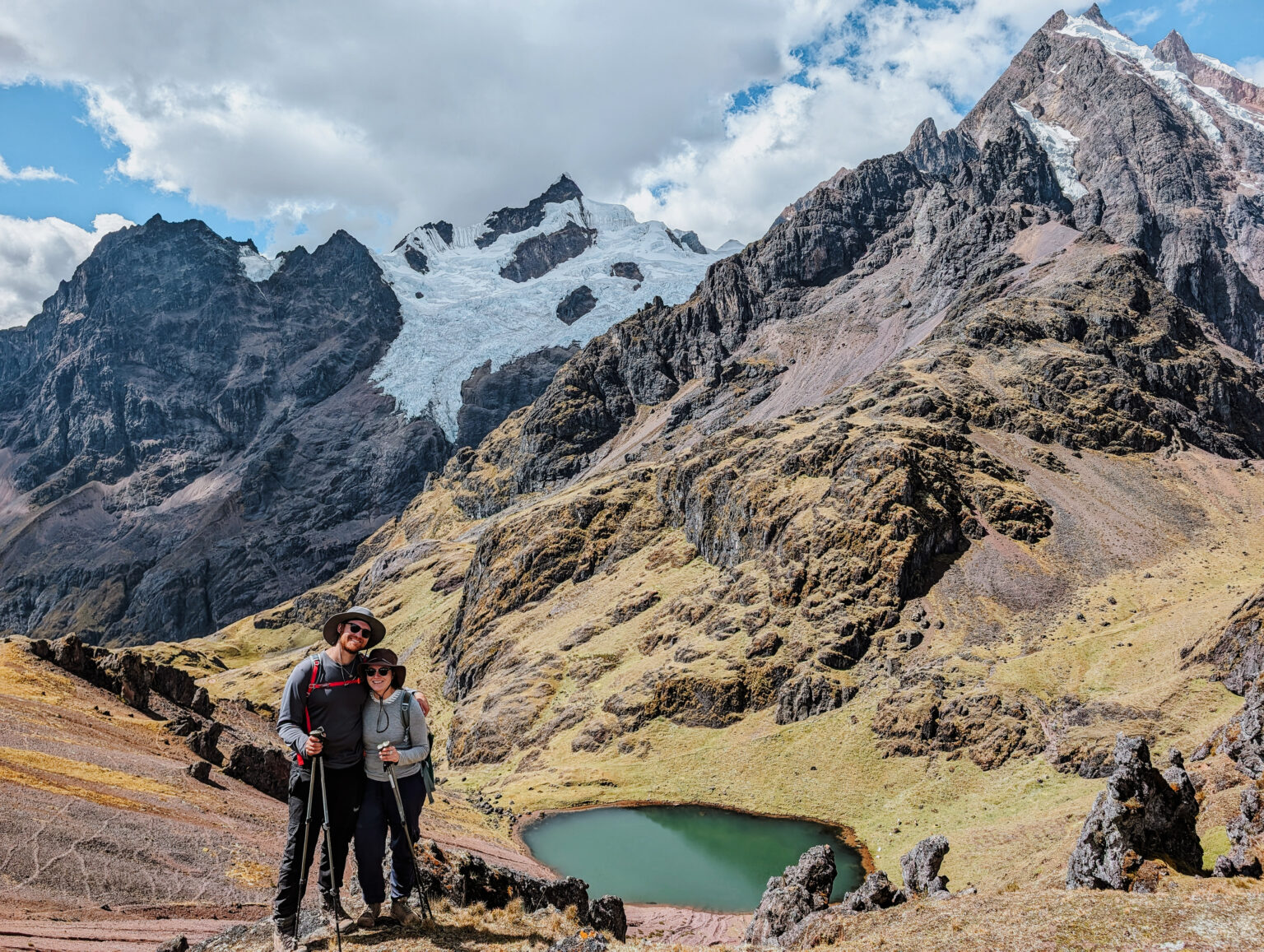The Lares Trek is a beautiful and poetic experience, hiking through the Lares Valley of the Peruvian Andes and winding around waterfalls, over mountains, and through local communities. There is a peaceful serenity all around as you make your way through the Andean highlands where people continue to survive with the ancient Incan and pre-Incan techniques and way of life.
This hike typically takes three days with a complete disconnect from any cell service, allowing you to immerse yourself fully in the region’s beautiful nature. Camping in those surroundings enables you to hear the noises of the farms, life, and nature all around you.
We chose to hike the Lares Trek when we could not get the permit to do the classic Inca Trail four-day trek. We were interested in the hike’s cultural aspect and learning more about the high Andean culture that dates back to before the Incan empire. The landscapes we got to experience were beautiful and the hike itself was just challenging enough to push us but not so hard that we could not take in our surroundings. The following is an account of the itinerary of the trek and the organization we used for this experience.
The Pre-Trek Briefing
Before starting the hike, we had to attend a pre-trek briefing at the agency’s office, Alpaca Expeditions, which we had chosen. While sipping on coca tea (to help with the altitude), we met our fellow hikers, Marta and Jorge from the Cannery Islands in Spain, and our fierce guide, Max, from the high Andes of Peru. We received a breakdown of what we would need to pack in the duffle bags provided and a brief explanation of what each day would entail.
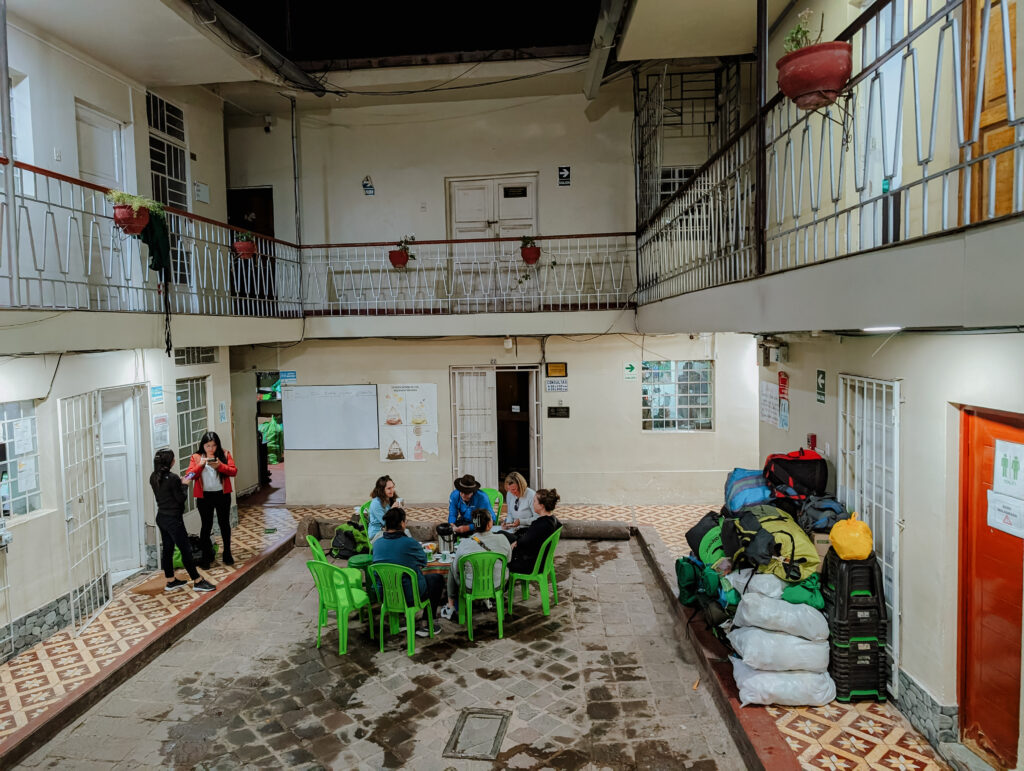
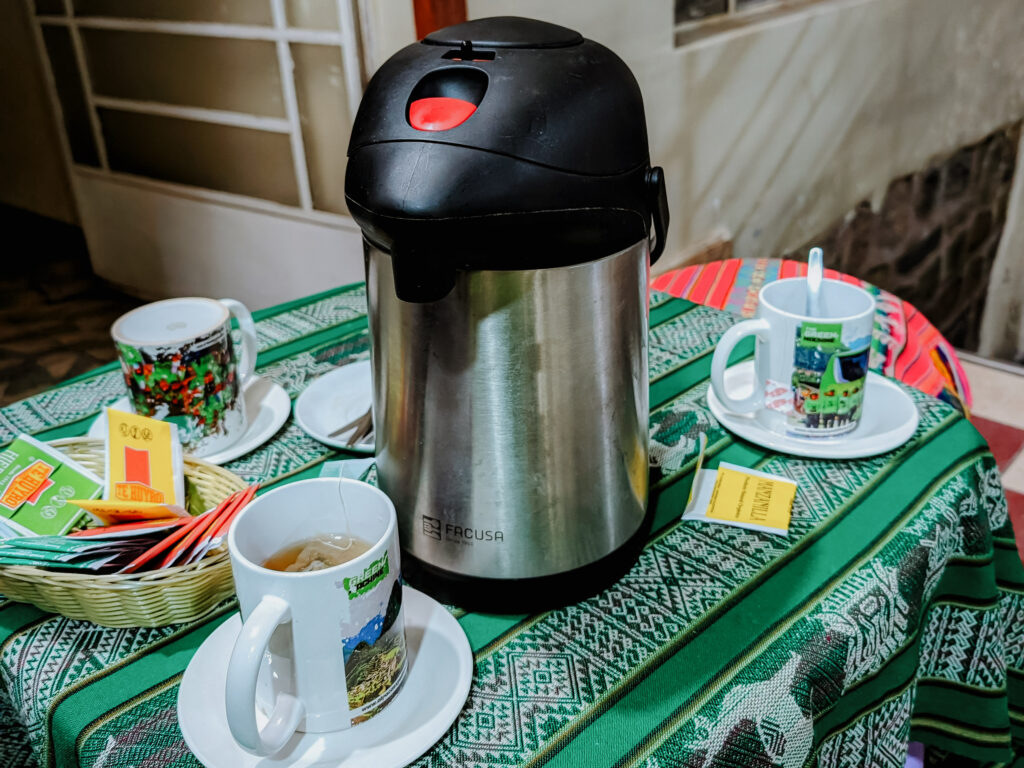
The Lares Trek Itinerary
Day 1
5:00 AM: Get picked up from the hotel
6:30 AM: Visit a local market
8:00 AM: Visit Ancasmarka and eat breakfast
10:45 AM: Soak in the thermal baths
12:45 PM: Start the Lares Trek hike (1-2 hours)
2:00 PM: Lunch
3:30 PM: Continue hiking (1.5-3 hours)
6:30 PM: Tea time
7:30 PM: Dinner
8:30 PM: Bedtime
Day 2
5:00 AM: Wake up and pack bags
5:45 AM: Breakfast
7:00 AM: Start the next portion of the hike (2-3.5 hours)
9:00 AM*: Condor Pass and snack
9:45 AM*: Continue hiking (1-2 hours)
10:45 AM*: Pachamama ceremony
11:15 AM*: Continue hiking (2-3 hours)
1:30 PM: Lunch
2:30 PM: Continue hiking (1.5-2.5 hours)
6:00 PM: Tea time
6:45 PM: Dinner
8:00 PM: Bedtime
Day 3
5:00 AM: Wake up and pack bags
6:00 AM: Breakfast
6:50 AM: Start the next portion of the hike (3-4 hours)
10 AM*: Arrive at the end of the hike
11:30 AM: Lunch
1:00 PM: Depart in the van
1:45 PM: Visit the Maras Salt Mine
3:40 PM: Arrive in Ollaytantambo
*Some times listed depend on how quickly the hike takes you
The rest of the itinerary will be the Machu Picchu experience (either one or two-day options).
All About Alpaca Expeditions: 100% Peruvian Owned
When looking for a company to go with for this adventure, we chose to partner with Alpaca Expeditions for several reasons. First of all, it was clear that they exceeded the expectations of tourists, having some of the best reviews for a tour agency that we’ve ever seen. More importantly, they are an organization that truly values the people who work for them.
The agency was founded by Raul who, coming from a rural region of Peru, started working as a porter on the Inca trail. With this role, he fell in love with creating an experience for tourists to the region and pivoted his career to start a company that puts the experience of the tourists along with the experience of the employees at the forefront of the operation.
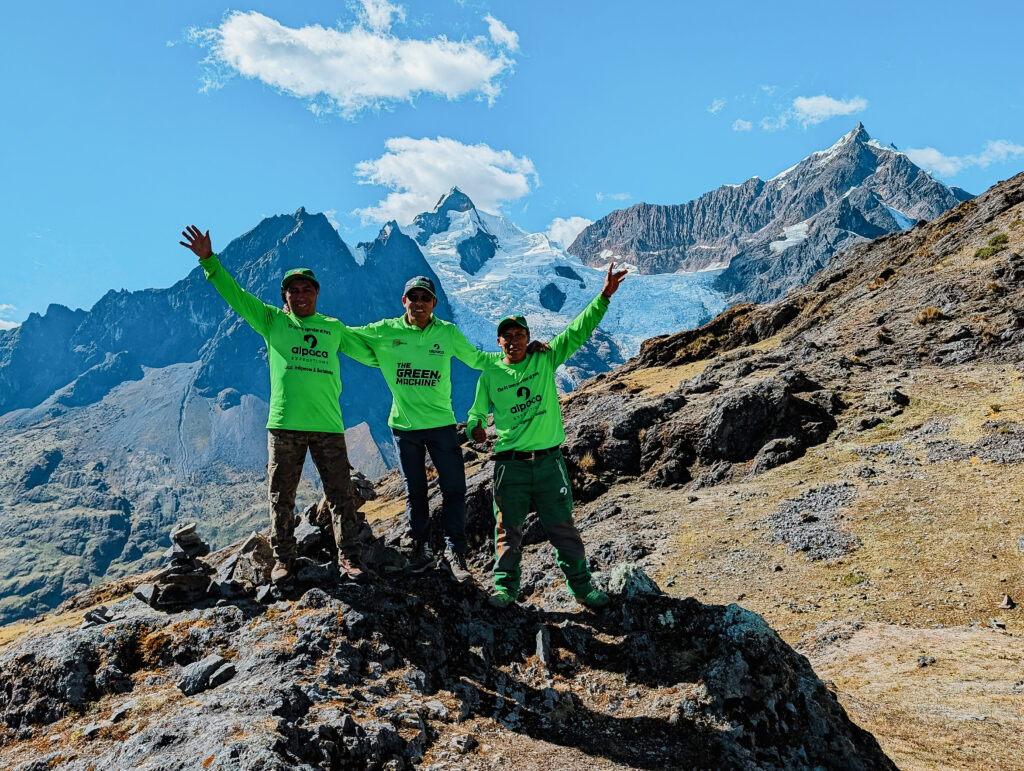
Three different roles help you out when you are on the trails around Machu Picchu (including the Salkantay and Lares Treks): the guides, the chefs, and the porters. With all of these roles, Alpaca Expeditions is one of the first agencies (if not the first agency) to hire both men and women, empowering women in these communities where they may not have had these opportunities previously.
The guides speak Quechua (the traditional language of the region), Spanish, and English, teaching you about the history, archaeology, flora, fauna, and culture of everything around you. They are trained in first aid, geography, history, architecture, and more!
The chefs travel with the tour group and cook breakfast, lunch, and dinner for the group. The delicious meals are served buffet-style and there is always more than enough food for the group (although no food gets wasted and the leftovers are eaten by the team). We had heard about the meals before going on the trek but it was truly hard to believe the flavorful and nutritious meals we were consuming while hiking. These chefs are true magicians on the trail, even carrying the gear they use and running ahead of us to make sure the meals are ready upon our arrival.
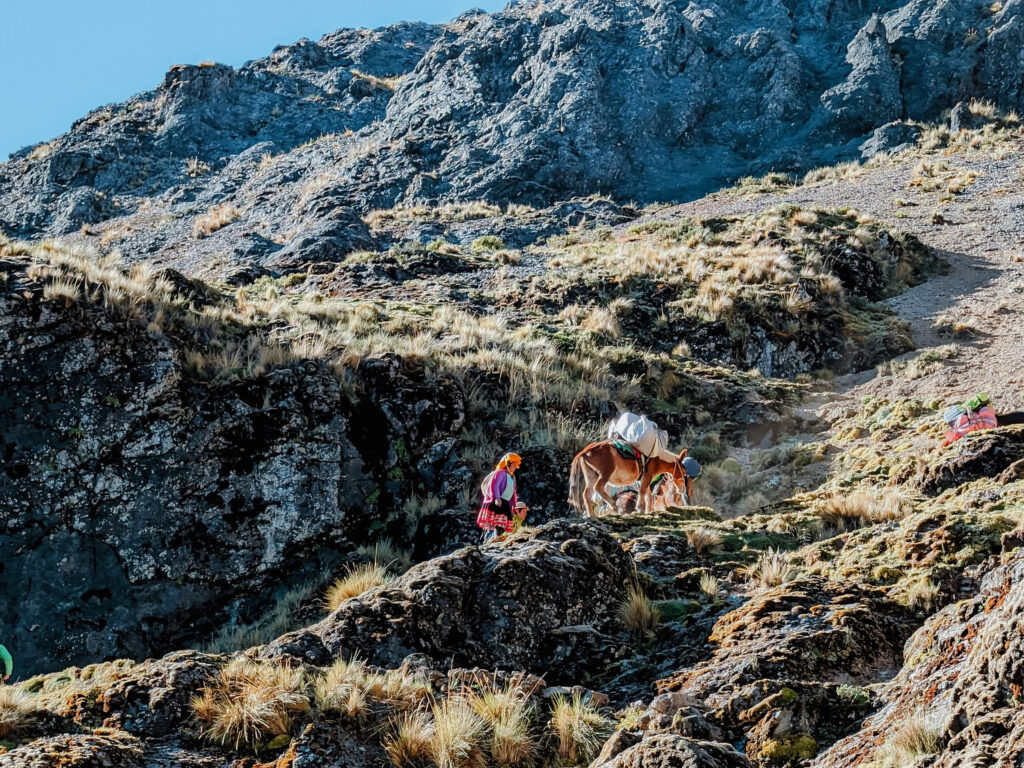
Finally, the porters are the backbone of the entire operation. They carry all the gear needed during the trek, including your clothes, either on their backs or with mules and horses. They set up and take down every campsite and are the background characters making the whole experience incredible.
Beyond the Trekking
Alpaca Expeditions truly values the hard work of these porters. While all of the porters work on the Inca trail, most have never had the opportunity or the means to visit Machu Picchu. Alpaca Expeditions provides a trip for some of their porters and their families to visit Machu Picchu during the off-season as a thank-you for their hard work. They are also provided with all the necessary equipment for their treks, including shoes, shirts, pants (or skirts for women who do not want to break their cultural norms), hats, and other items. There is so much more that Alpaca Expeditions does that is above and beyond the requirements and expectations that other agencies have set and you can read more about that here.
Beyond the internal community that Alpaca Expeditions has created, this company makes sure to give back and elevate the communities around the Sacred Valley and High Andes regions. There is so much information about this on their website but some of the efforts include:
- Ricsishun Nukanchispata (Knowing Ours in Quechua) – a program that brings kids to different archaeological sites and the Rainbow Mountain, along with a guide and chef from Alpaca Expeditions so they can explore and learn about their Incan history, something they did not have access to previously
- Cleaning Campaign – every year, Alpaca Expeditions staff walk the trails and pick up any inorganic trash that they find along the trail
- Reforestation Campaign – Alpaca Expeditions donates and plants 10,000 local trees in the communities to help fight the forest fires and deforestation issues of the region
Day 1: The Start of the Adventure of the Lares Trek
We started our day at 5 AM, establishing a precedent for the coming mornings. From our hotel pick-up, we headed to the large Modelo market in the town of Calca full of everything we could imagine.
A Classic Morning Market
Aisles lined with cheese, vegetables, fruit, beans, maize, fish, and meat; a rainbow of produce fresher than anything we had ever smelled and just a fraction of the prices of our GMO-pumped “food” at the grocery stores of the United States. Our guide took the time to introduce us to vendors and select local fruit to sample right then and there. What is local to the people of the high Andes was exotic to us, and yet the delicious, sweet flavor of fruit is universal. We got our first glimpse of the diversity of the food of the high Andes, seeing the variety of beans, potatoes, and corn that are representative of the staples of the diet of the region.
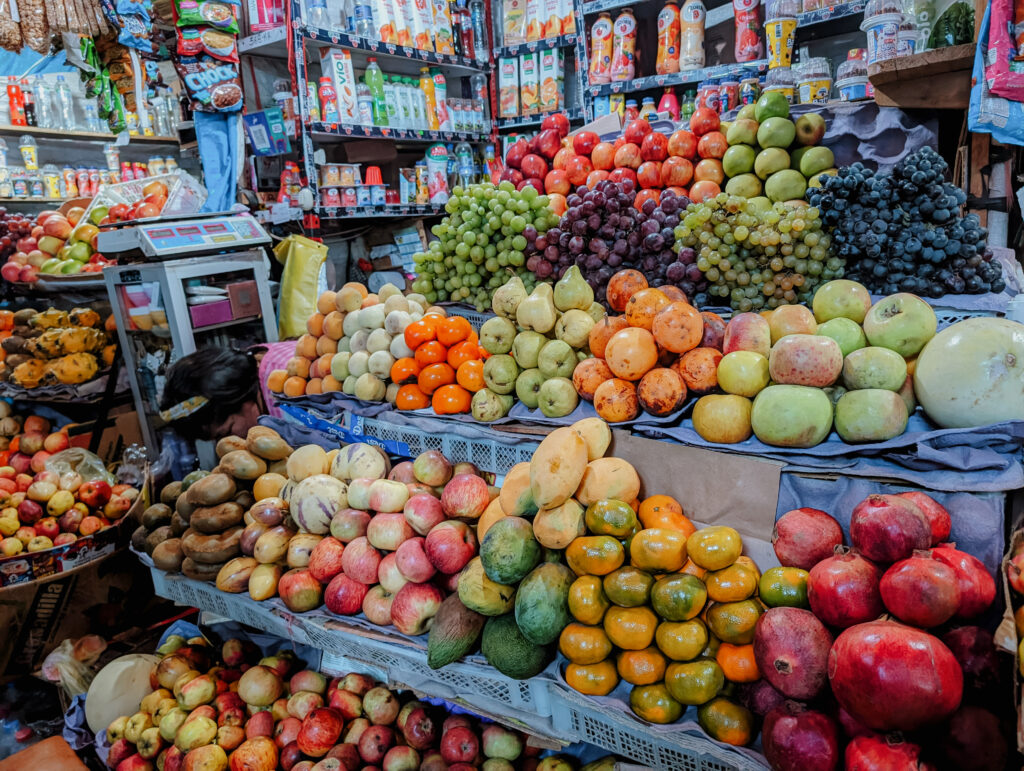
We took the opportunity to purchase some toys from the local vendor to hand out to any children we met along the way. We opted for bubbles, color books with crayons, and small soccer balls: items that a variety of ages could enjoy with no gender concept in mind. This tour moves us through real communities and it is important to show gratitude to these communities for hosting us, feeding us, and supporting us through our trek. This small sign of gratitude, from us to the children of these communities, is just the beginning of our cultural exchange here.
Ancasmarka, Breakfast, and a Surprising Thermal Bath
After the market, we arrived at our first archeological site, Ancasmarka. Ahead of us were numerous silo-like structures, used in the Incan period to store food for extended periods, helping the society get through dramatic famines and dry periods as well as the years of excessive rain and flooding. It is located in the famous Sacred Valley, a valley known for its fertile soil and unique climate that truly allows agriculture to thrive.
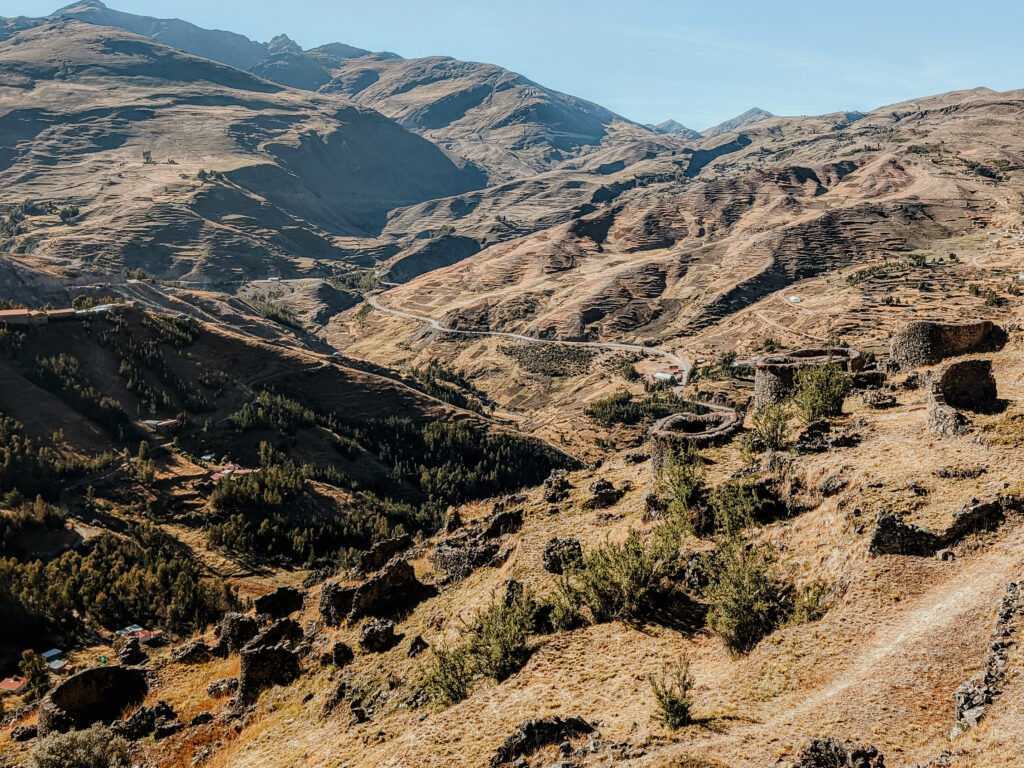
While these remains are not conserved or restored, you can freely walk through the site, exploring between these dilapidated round structures. It is here that we realized that most Incan ruins are not protected and maintained by the Peruvian government. There are many gems buried throughout the valleys of the area that have some significance to the ancient Incan society; so many so that they are just part of the landscape of the region that continues to morph and change due to the climate and weather all around.
We then had our first meal provided to us by the incredible chef team who would be rooting for us along the entire trek. They made sure we had more than enough to eat and filled our bags with snacks to hold us over before lunch. We truly never went hungry during the whole trek and any snacks that we did not need, we were able to donate them to local children or families we met along our hike.
Before starting our hike, we had the chance to go to a local thermal bath, the Aguas Termales Lares, with pools with water ranging from warm to hot. (I wish I had brought a small packet of shampoo to rinse out my hair in the provided showers after soaking in the baths for about an hour.) We took the chance to soak in the sun and relax in the hot water to prepare for our next few days of hiking.
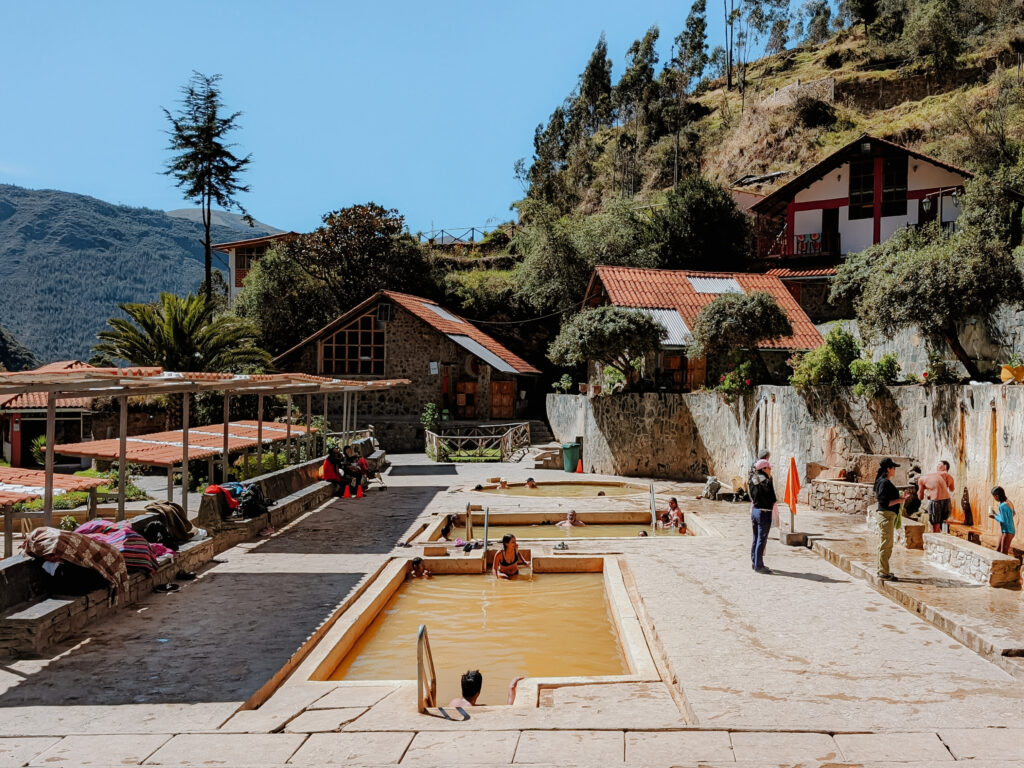
Beyond the thermal baths, our guide showed us a hidden path that led to an Incan ceremonial and cemeterial site complete with the bones of multiple humans from Incan times. An Incan burial site. Just a short hike up a hill. With no explanatory plaque or gate preventing anyone from just moving and touching these bones. Of course, the site had previously been looted with all the gold and the majority of skulls stolen from the location making it impossible to reconstruct what it had once been. There must be thousands of other archaeological sites that are just casually around the Incan empire that are hidden gems for people to discover through conversations with locals (which is how Machu Picchu was discovered a little over 100 years ago). It made us think, how do we choose the archaeological sites to put a value on and decide to restore to former glory? And when does an archaeological site just become historical remains that merge into the landscape?
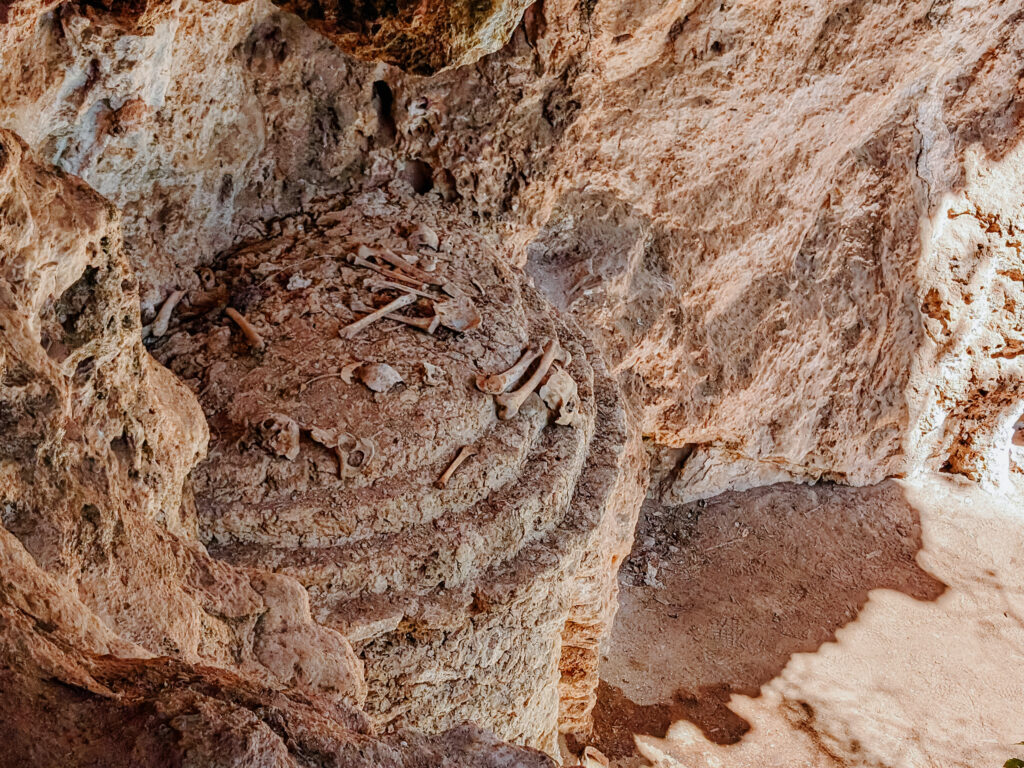
Hiking to Lunch - the Official Start of the Lares Trek
Now, it was time to start our hike. This would be the last time we would see a vehicle for the duration of our hike. Our chefs and bags would be waiting for us at our lunch location, preparing a delicious feast while we started to discover what we had gotten into. I will say that this start was relatively flat, truly easing us into our hike. And soon enough, we arrived at a greenhouse in a village where we would be eating lunch.
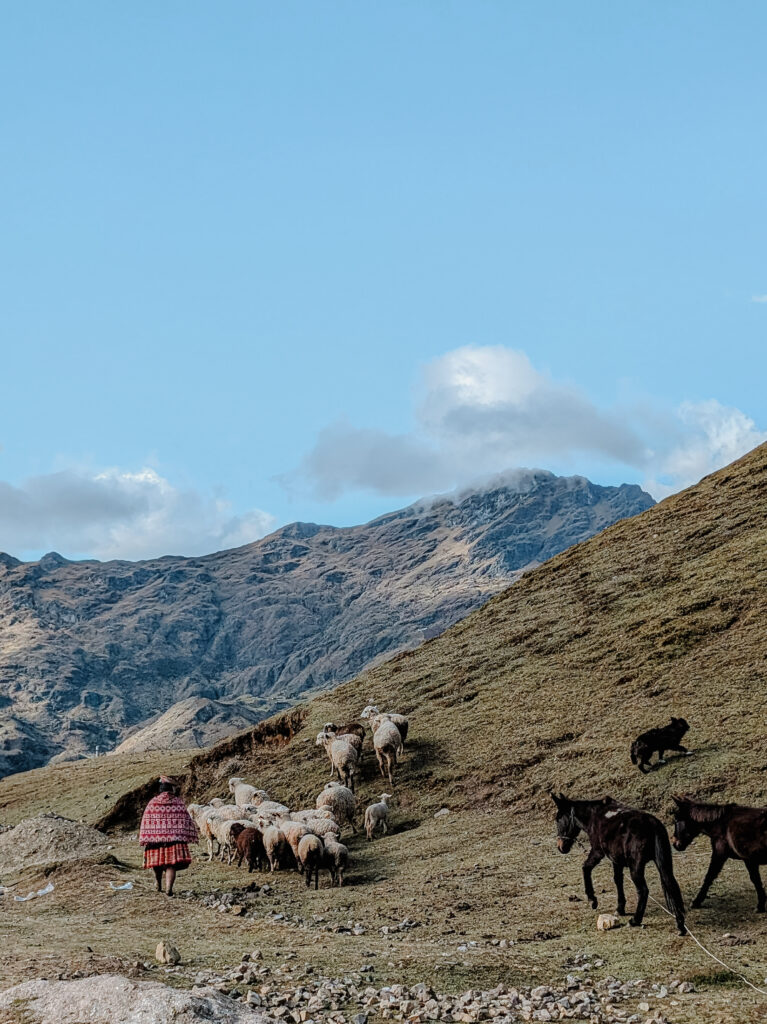
We had the chance to lay out in the sun and take in the beautiful surroundings that would be our home for the next few days. The meals that we would be provided were all different and delicious but they followed an outline that ensured that we would never be hungry. Our chef started our meal with a homemade juice of chicha morada (a juice made from purple corn). When we got to the table, we had a vegetable soup, which helped warm us up. Next was the main event: a buffet spread of avocado filled with vegetables, rice, potatoes, a bean salad, and breaded trout. There was no way we could finish it all but we were assured that if everything we didn’t finish would be eaten by the chef and porters of our trek.
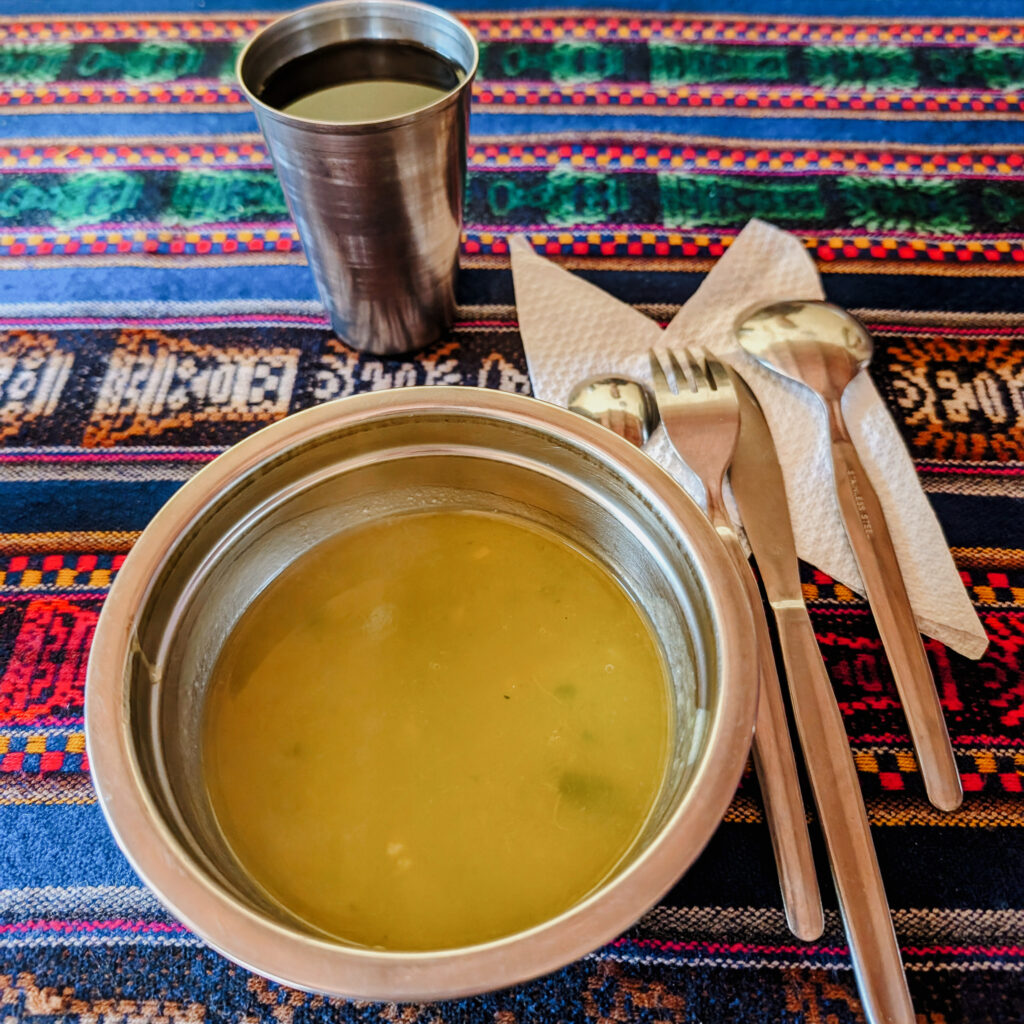
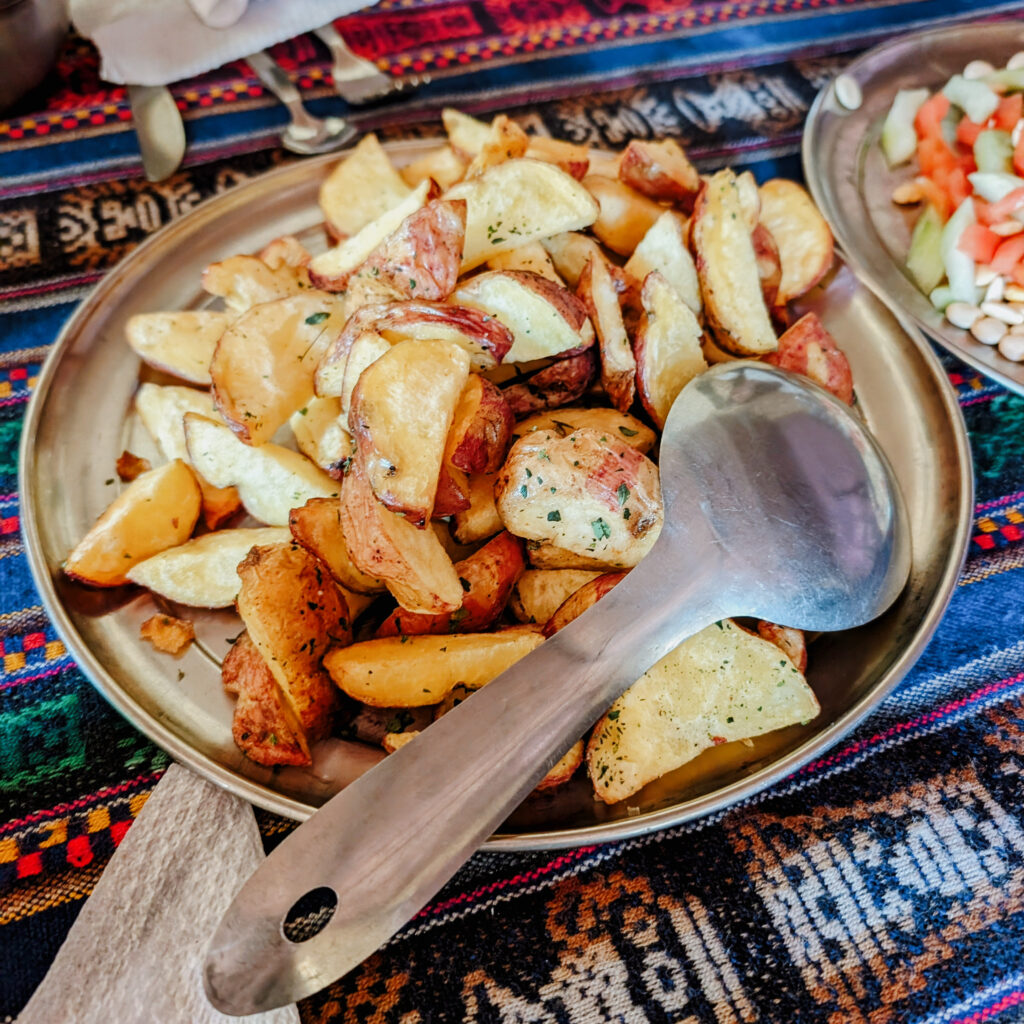
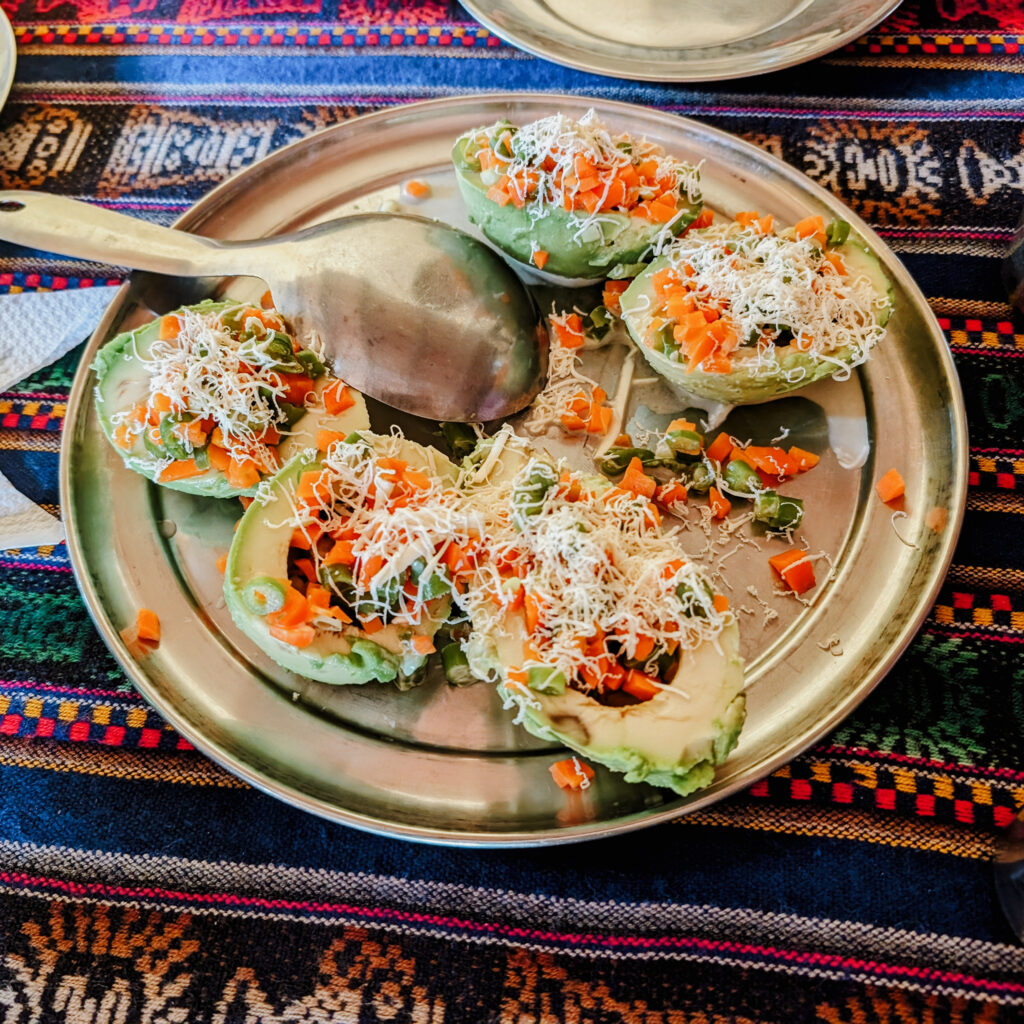
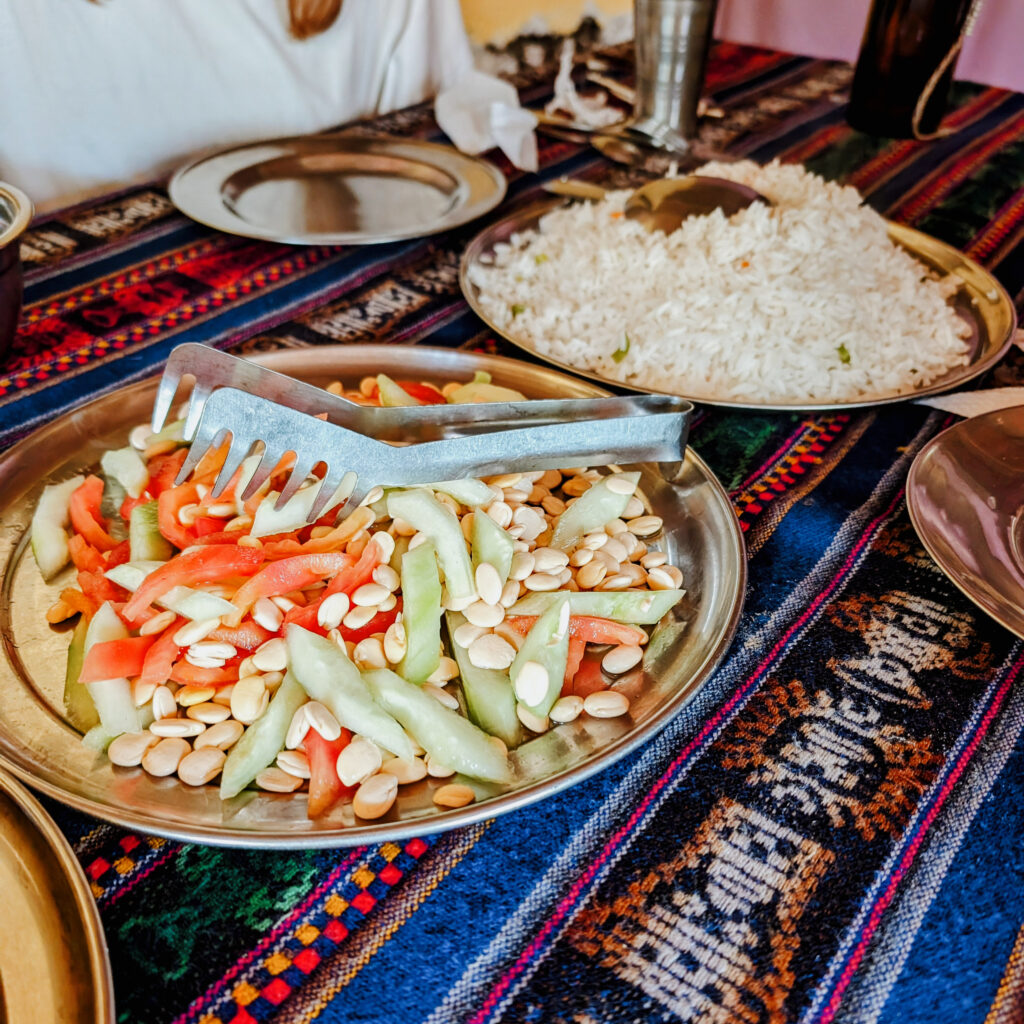
The True Hike Starts
After lunch and a short siesta, we continued on our hike, getting deeper into the valley. The trail slowly started to get steeper as we wound between a small river and the farmlands of the residents. We soon arrived at the Seven Waterfalls viewpoint, a beautiful place where the river splits into seven different waterfalls as it flows down the valley. It quickly merges back into one river. Here, just an hour after we had left the lunch spot, our chef and porter team caught up to us after cleaning up the lunch and packing up the horses and mule team to bring all the equipment to our campsite. This impressive team worked fast and efficiently.
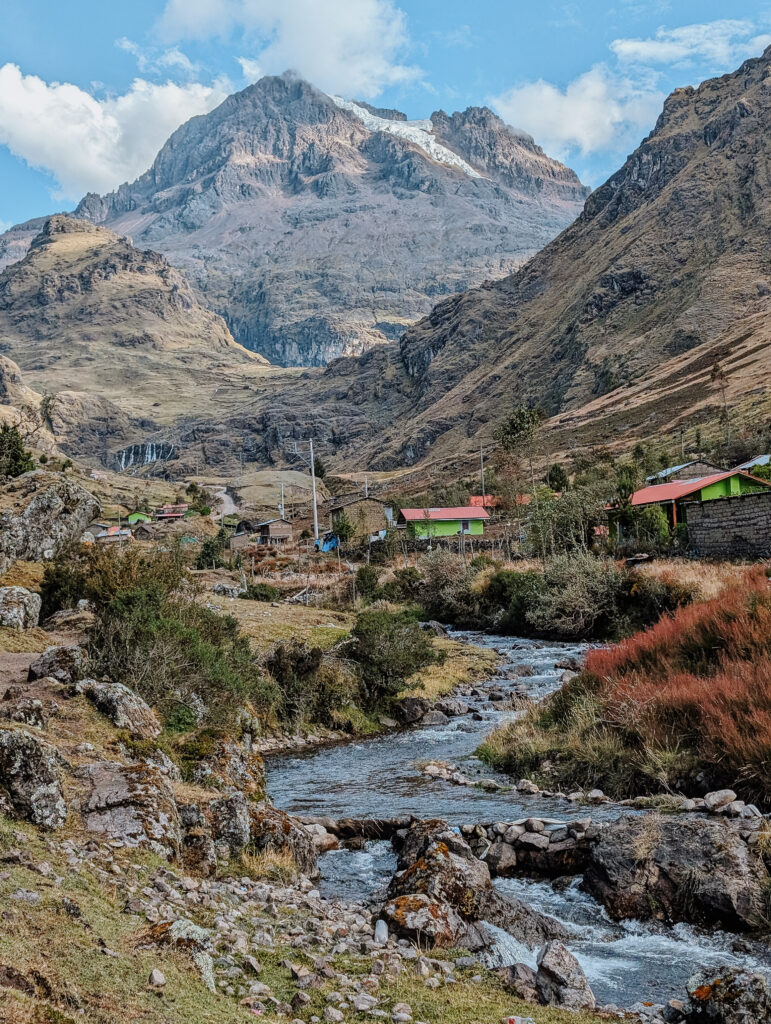
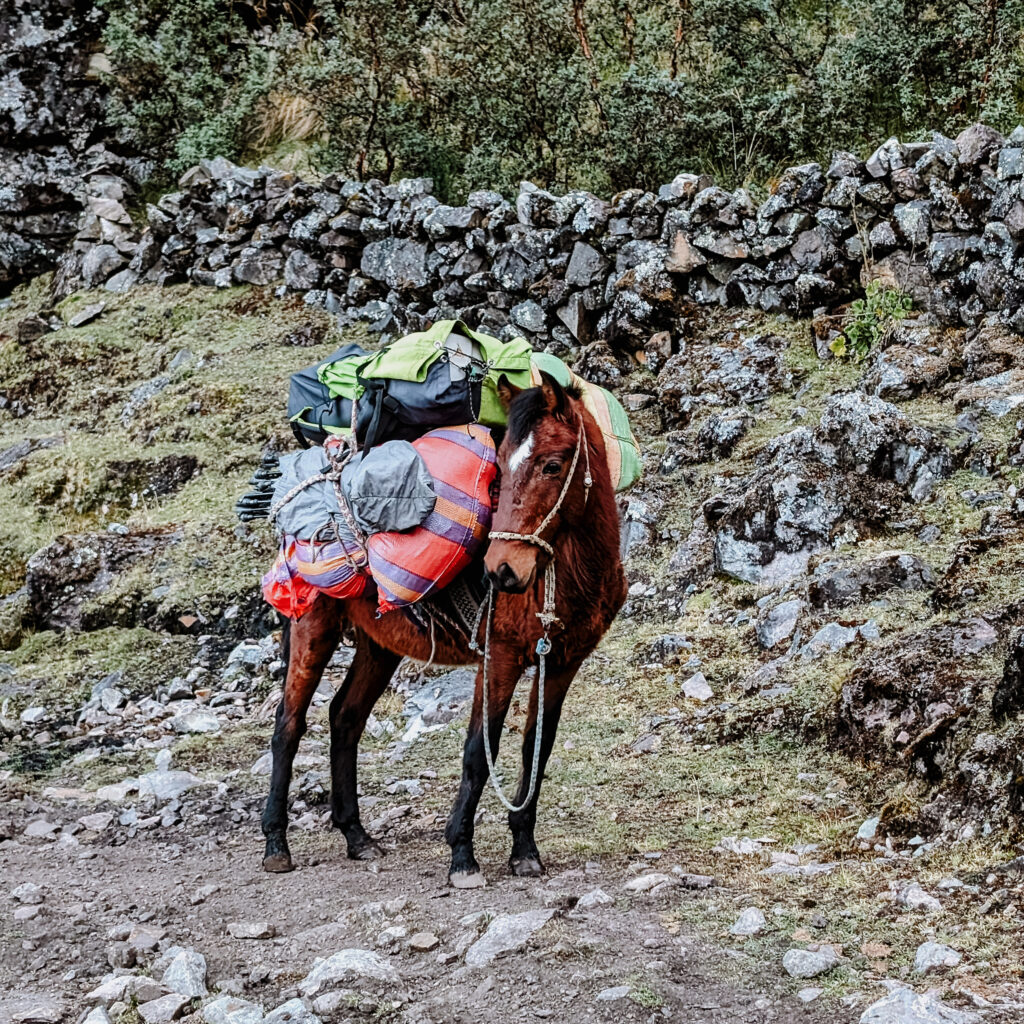
While the team scurried ahead of us (they are used to the altitude!) we continued at our less-seasoned pace, taking in the surroundings. The hike slowly got steeper. We knew that during Day 2, we would reach the summit of a mountain and we were getting a start on this climb on this first day.
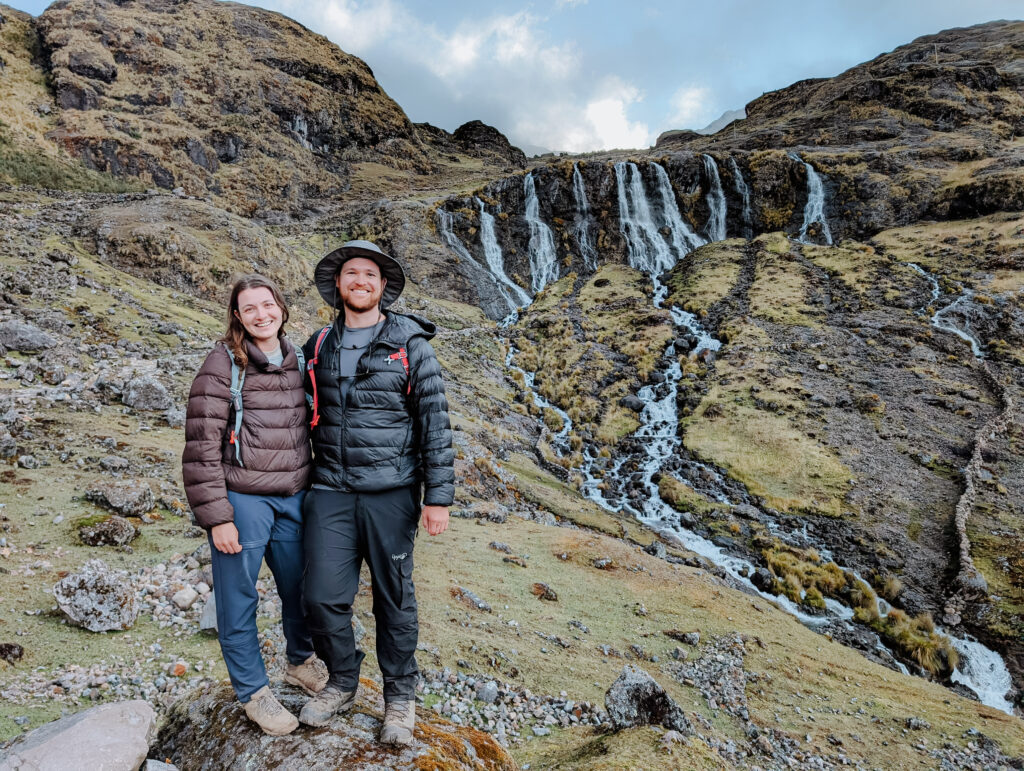
Eventually, we turned the corner and saw a beautiful and serene lake ahead of us. This is where we would be camping for the evening. The team had already started setting up our tents along the shore of this lake. The hills above us were full of alpaca and llamas, grazing on the hillsides. We were able to decompress from our 2.5 hours of hiking, watch the fog roll in and out of the valley, and observe the alpaca and llama herders bring in their stock for the evening.
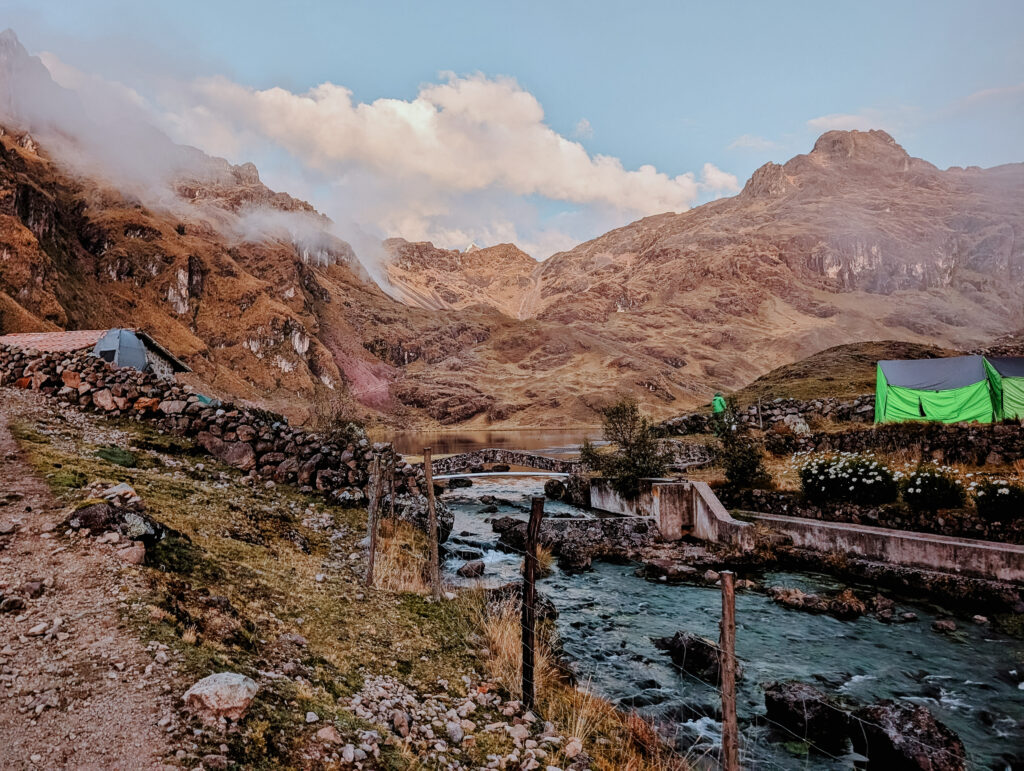
Alpaca Expeditions owns some of the camping or dining destinations that they use on these hikes. This helps with community investment and removes the additional burden of tourists on the community resources. It also means that some of these camping destinations are unique to Alpaca Expeditions. This particular destination along the lake was so beautiful that it added to the value of the entire experience. We knew we would be waking up to incredible views. When a camping location is not owned by Alpaca Expeditions, it is rented directly from the community.
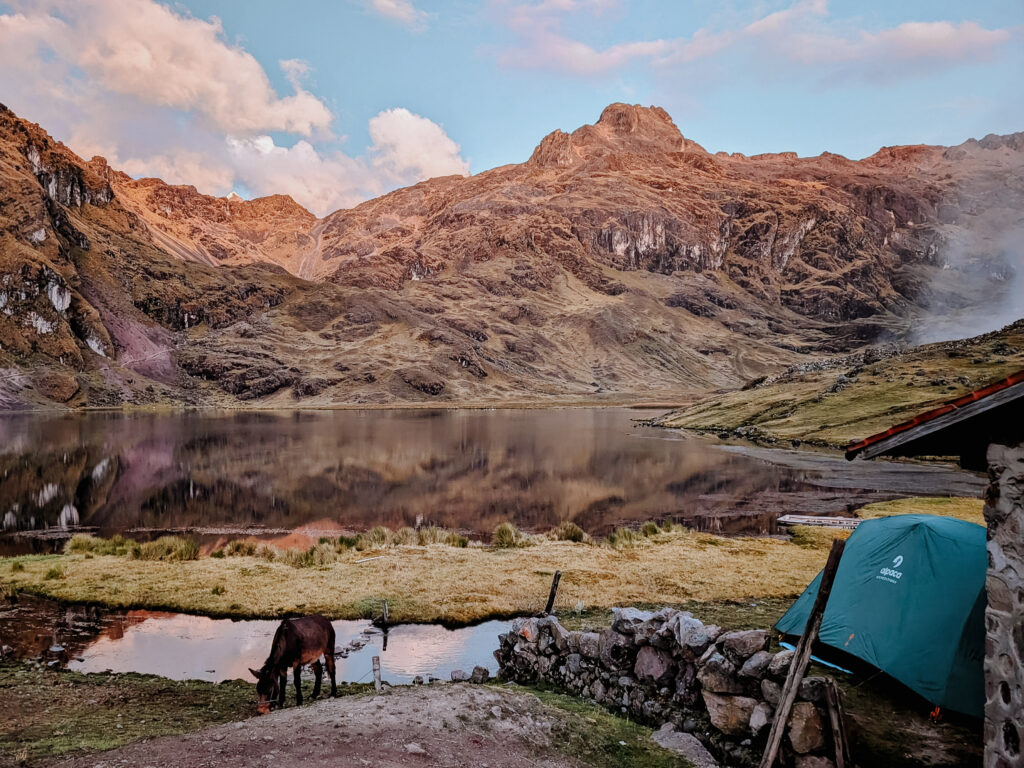
Dinner and Camping Set Up
We started dinner with a little tea time. This allowed us to talk about the day we had just had and discuss what to expect for our coming day, all in front of a tea and a huge bowl of popcorn.
Similarly to lunch, we started our meal with soup and followed that with a large spread of vegetables, carbohydrates, and protein to properly fuel us for the coming day (although the company could accommodate any dietary needs).
After dinner, we returned to our tent, stuffed to the brim, and ready to settle into our sleeping bags for the evening. During this trek, the evenings got particularly cold (it can fall below freezing) and we ended up wearing beanies, long sleeves, and leggings to keep warm during the evening. Alpaca Expeditions provided us with a water bottle full of hot water to help heat the inside of our sleeping bags and make it much more pleasant to get a good night’s sleep.
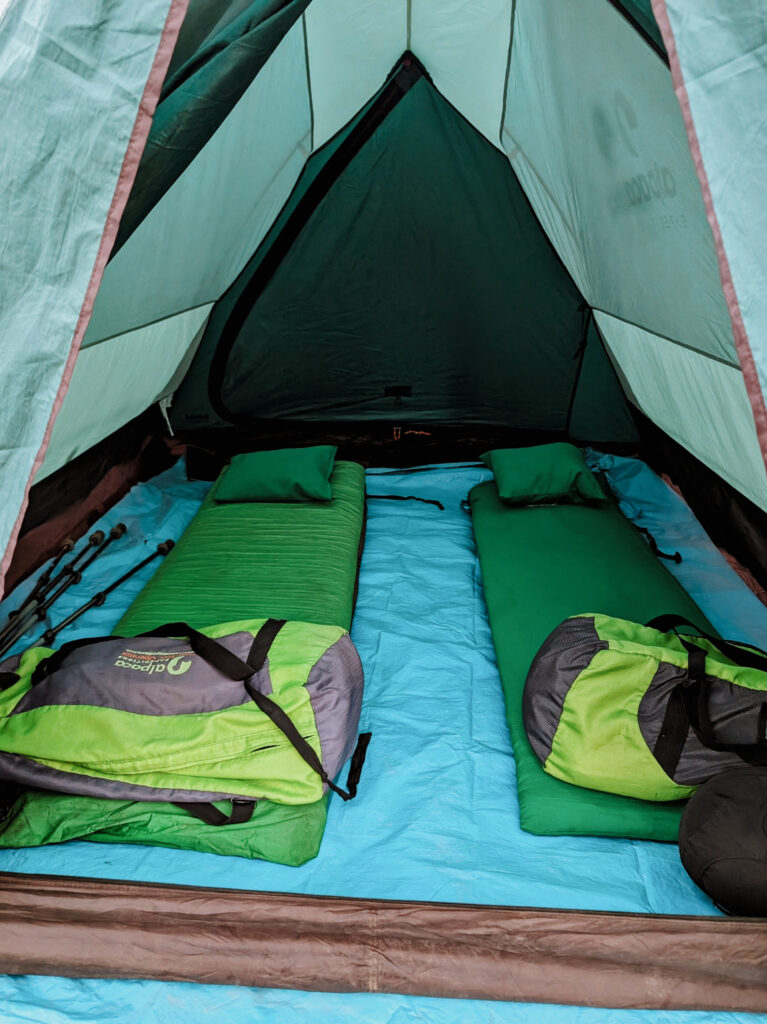
Camping does not allow us to have access to running water, toilets, or electricity. So, we had to pivot to make sure we still had the comforts we needed. Fortunately, Alpaca Expeditions provides a portable toilet and tent system to make going to the restroom easier at campsites. They also make sure we always have sufficient water in our bottles, properly boiling and cooling the water to make sure it’s potable. We also made sure to pack a portable battery to charge up our phones and brought headlamps to make the stumble to the bathroom easier.
Day 2: The Condor Pass of the Lares Trek
Wake Up Call and Breakfast
Once again, we were woken up at 5 AM, this time with a warm tea of coca leaves and some warm water with a towel to take a bird bath before getting dressed for the day. We packed up all our belongings into our duffel bags and emptied our tents to help the porters clear the campsite and head to the next destination.
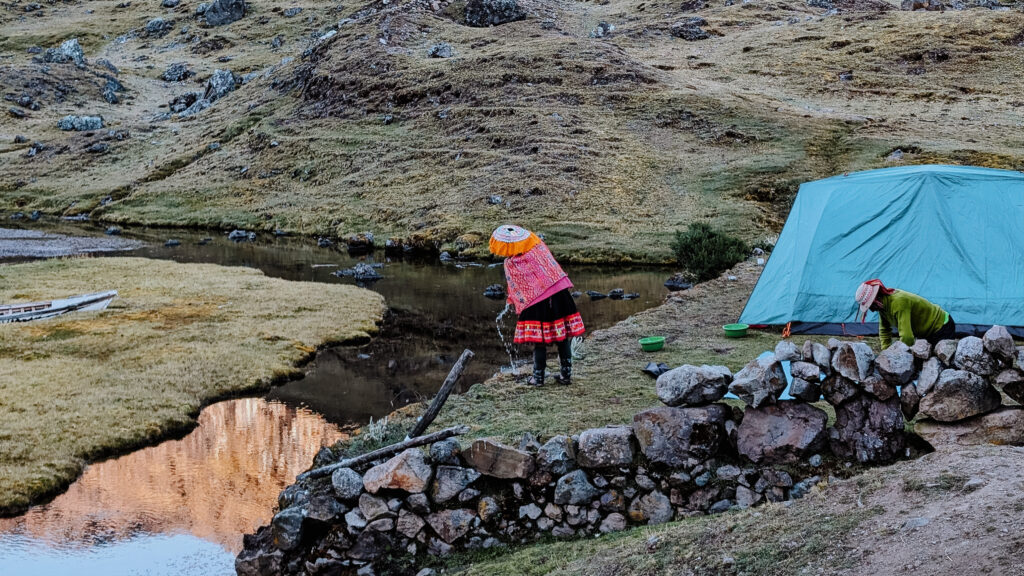
As with all the other meals, we were absolutely stuffed with food for breakfast, just in time for our most challenging hike of the trip. This section of the Lares Trek goes over the Condor Pass. We started our entire trek at 3,450 meters (11,390 feet) on day 1. Our first campsite was at 3,900 meters (12,795 feet). The Condor Pass would take us up to 4,650 meters (14,250 feet), an altitude that would have about 50% less oxygen than at sea level. While we had adjusted to the altitude by being in Cusco for a week, it’s hard to prepare for exercise at this elevation.
Up and Up and Up to the Condor Pass of the Lares Trek
It took us about 2.5 hours to reach our main stop with an incredible view of the mountains ahead of us. We were pretty fast hikers and most groups take up to 3.5 hours for this portion of the hike. We stopped a few times along the way to catch our breath (both because of the oxygen and because of the beauty of the landscape around us).
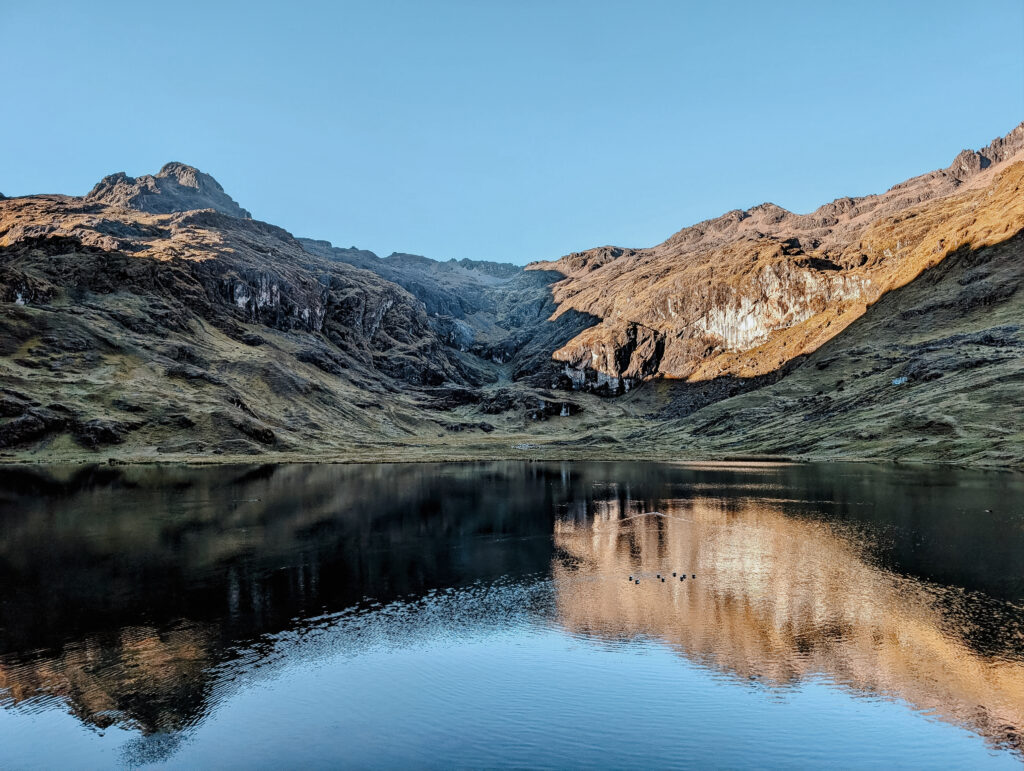
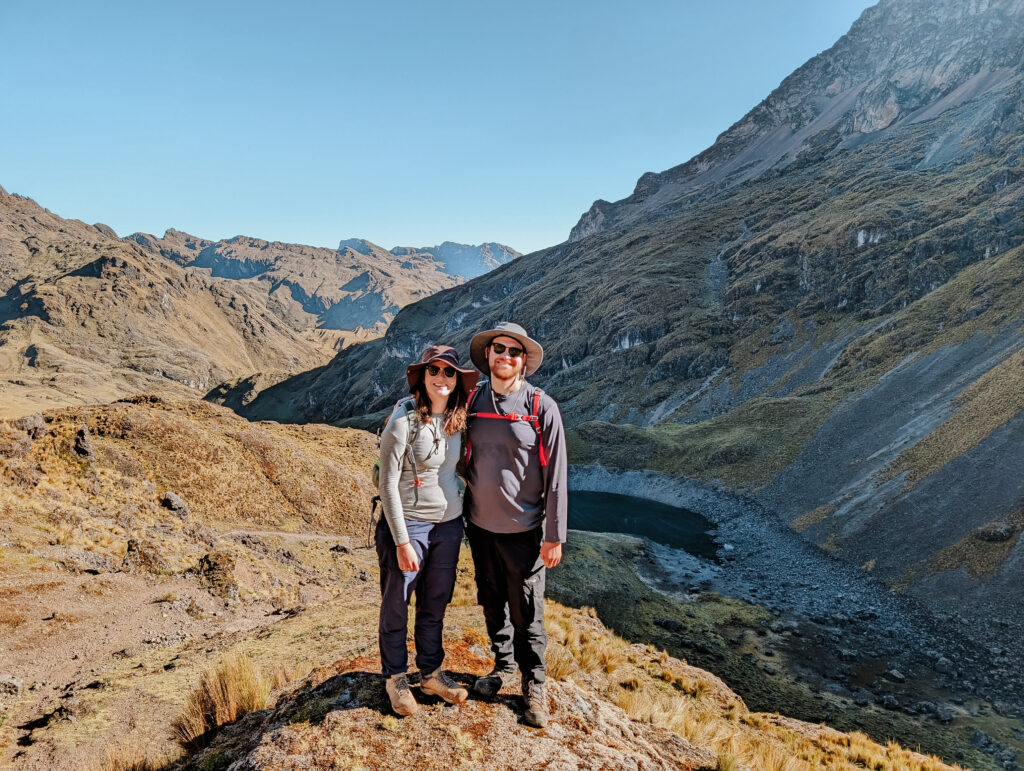
Finally, when we made it to the start of the Condor Pass, our trusty chefs were waiting for us with coca tea and cheering us on as we passed one of the more challenging portions of the hike. We got to rest for a few minutes and take in the beautiful view of the Lares Valley and the glaciers in front of us. And once again, our chefs sped ahead of us to the lunch spot further down the hike (they were just such fast hikers!).
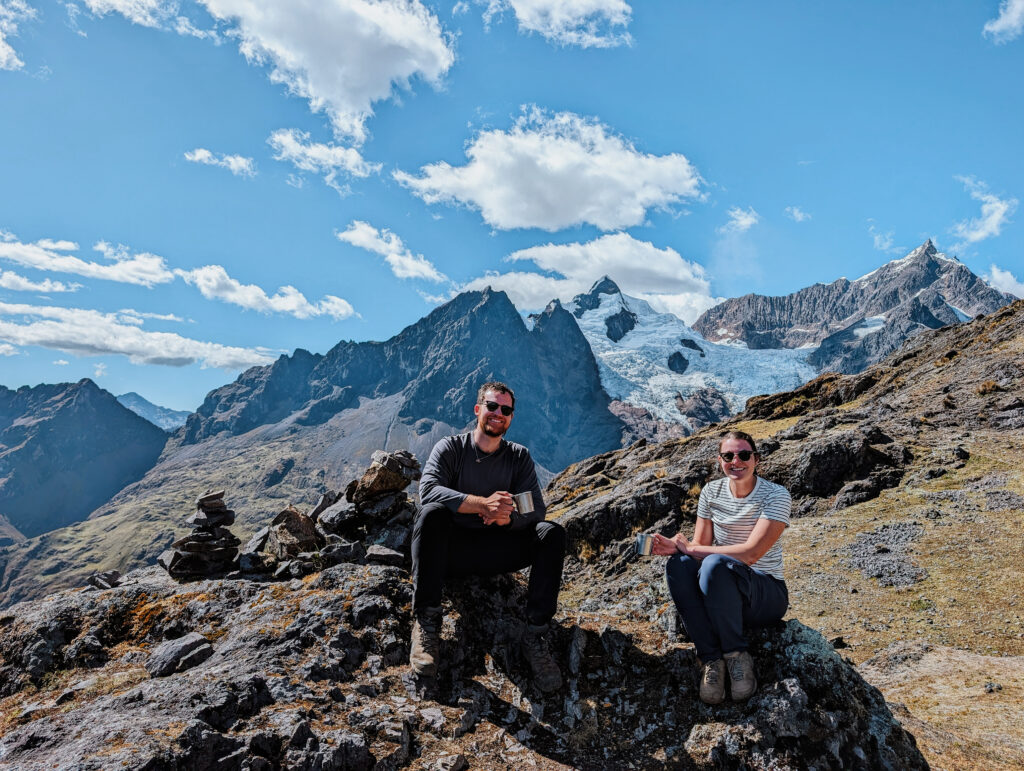
Our climb was not quite over yet; we had to continue onwards and upwards to reach the peak. To our left was the beautiful vista of two glaciers perched on the peaks of the mountains across the valley. Eventually, we reached a large rock where we were invited to participate in a traditional ceremony thanking the Pachamama (Mother Earth).
The Ceremony to the Pachamama and Heading to Lunch
This beautiful ceremony talks about our presence on this Earth now, what came before this moment, and what is to come in the future. It connects us to Earth, our ancestors, and our future selves. Overall, it grounded us in the moment and the experience that we were partaking in.
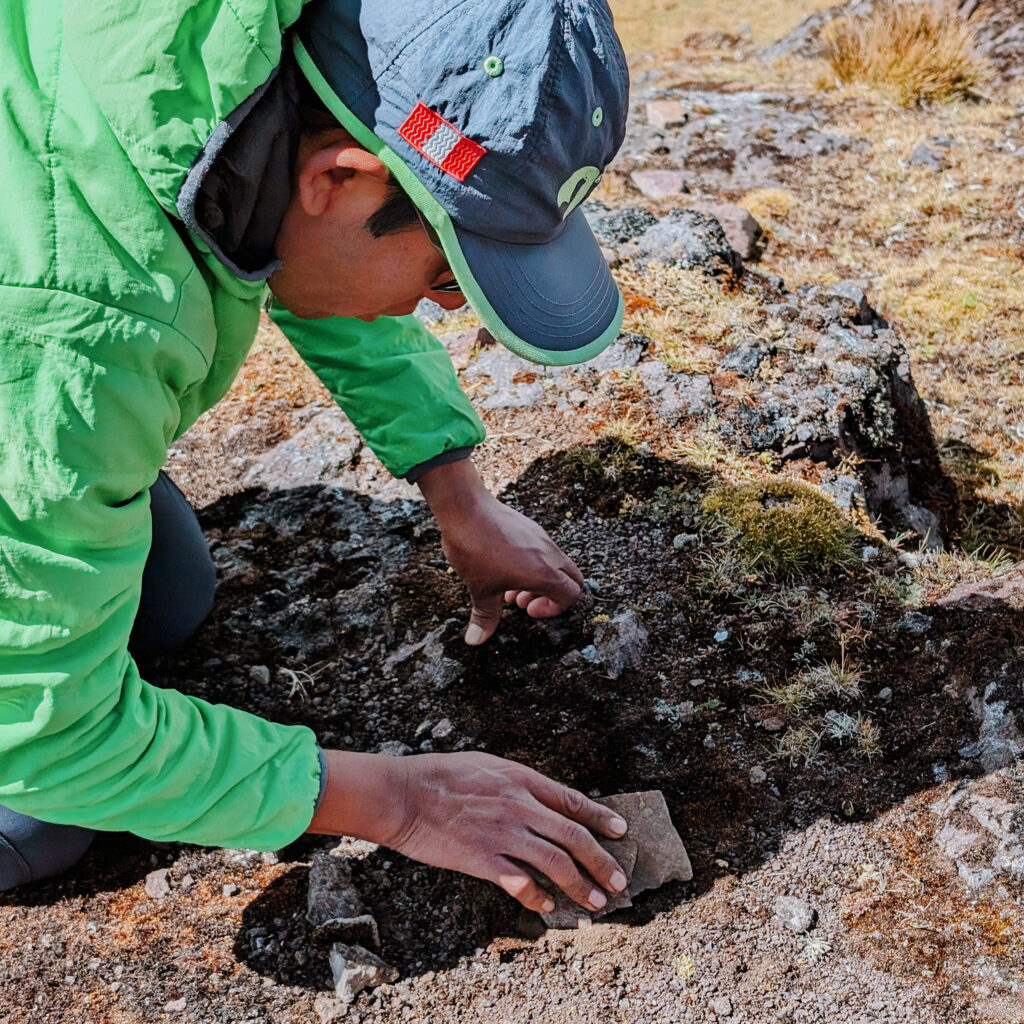
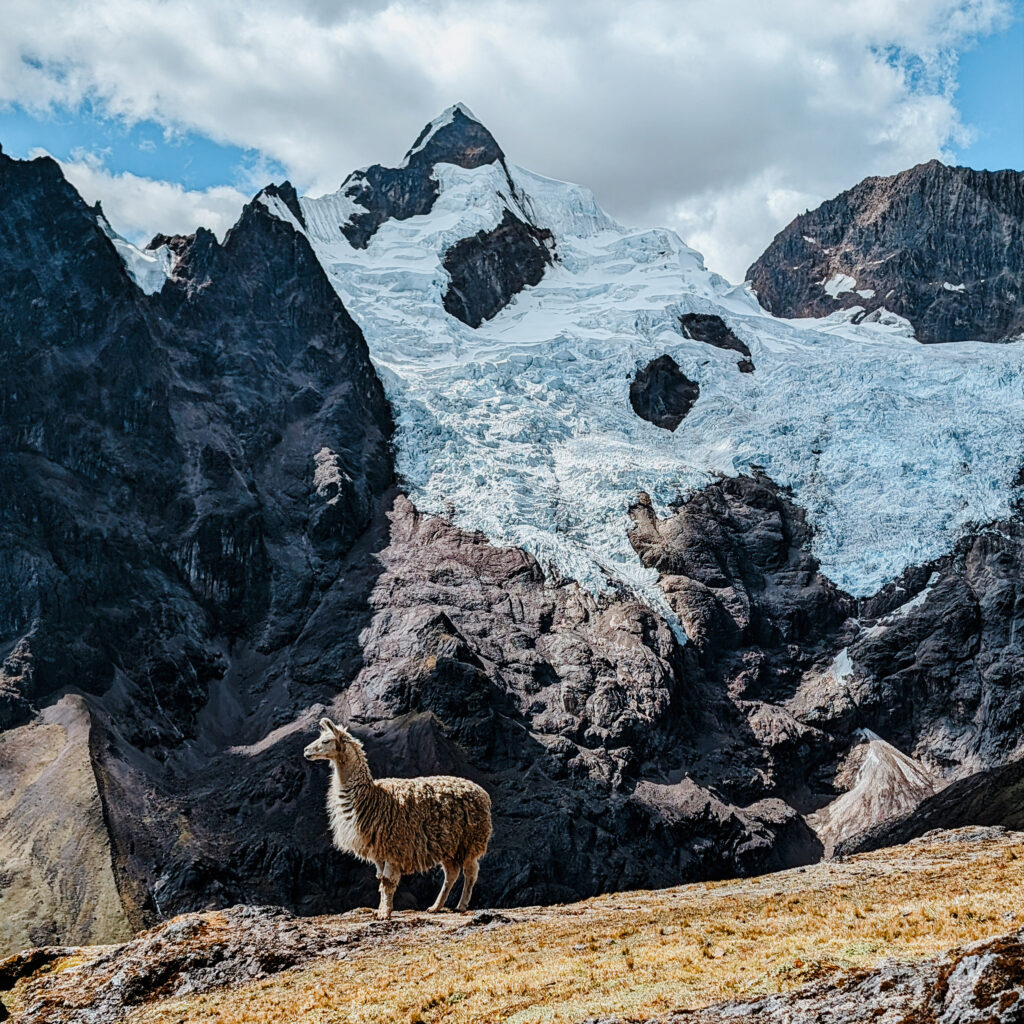
This was officially the highest elevation that we would be at and we could feel it. It was getting hard to catch our breath and the smallest movements were tiring. It was time to head down. As we went down the mountain, the terrain started to change with plants and shrubbery getting larger and greener. From the Condor Pass at 4,650 meters (14,250 feet), the rest of the trek was heading down to 3,750 meters (12,305 feet) for our next campsite and, ultimately, 2,700 meters (8,858 feet) to finish the hike on day 3. We followed a stream, saw a few lagoons, and started seeing more and more llamas and alpacas. Finally, we made it to our lunch spot where our chefs had already set up a feast in a field full of grazing alpacas.
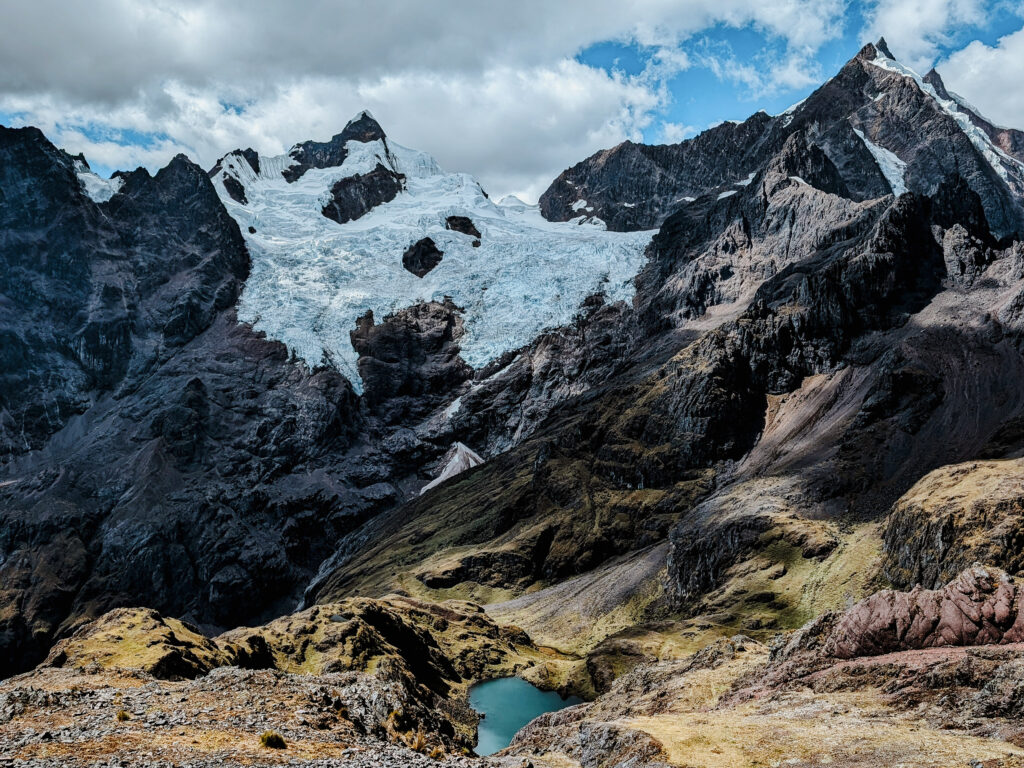
Walking Through the High Andes Communities on the Lares Trek
At lunch, we met a woman from the community who was selling some woven and knitted goods to us. She told us (through our guide in Quechua) that life here in the High Andes was truly challenging. When her sister was very sick a few weeks ago, she could not get to a clinic or hospital because there are no roads that access this part of the Andes. Eventually, her sister was able to get a horse to transport her to the nearest clinic. This helped put into perspective that the paths that we were hiking were the primary transportation networks for these communities.
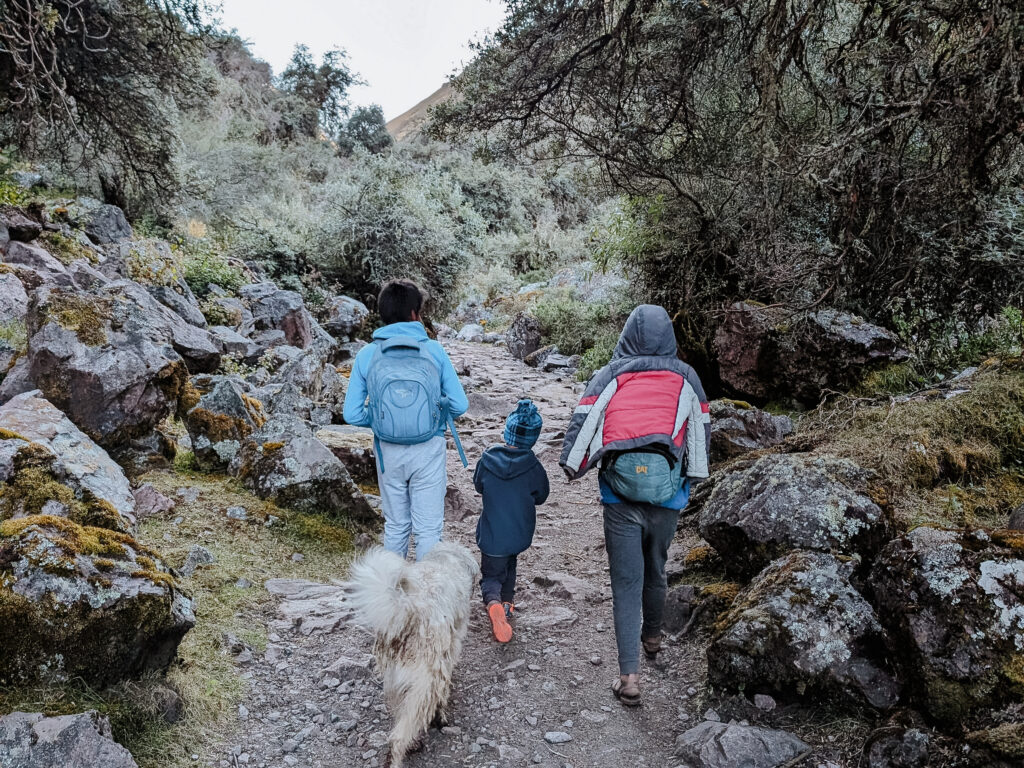
A few times, we ran into some kids who were eager to meet us and get some food and toys. It was always nice to see their face light up when we showed them how to blow bubbles, when we asked them about their favorite soccer player (usually Messi or Ronaldo), or when they saw the crayons we had brought them. Some of these kids have to walk a few hours to and from school to get an education. Then, in the evenings and on weekends, they help their families with the farmwork. In the future, many of these children will choose to move away from the high Andes to pursue different education opportunities. Life on the high Andes is incredibly hard but what will happen to all the small farms of the region? Because of the altitude and climate, particular potato and corn varieties can only be grown in this region. What will happen to these products and this agriculture hub in the future?
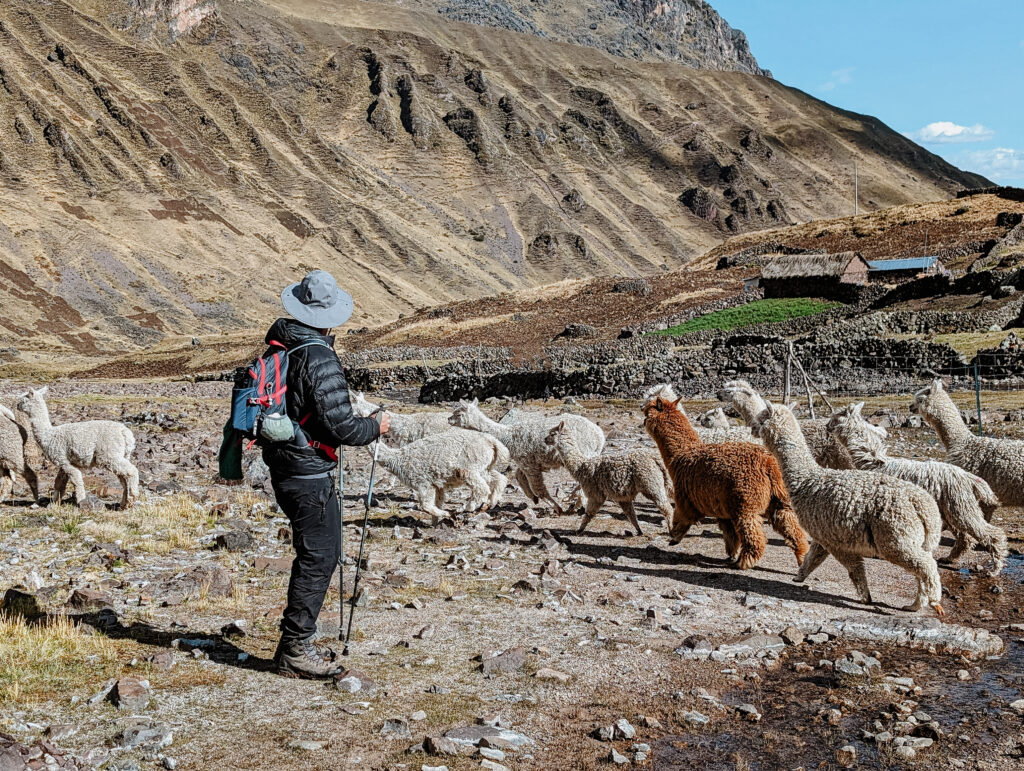
We got to see these farmers harvesting potatoes in their fields. The end of May is the harvest season and these farmers manually dig up the potatoes, separate them, and determine which ones can be sold at the local markets. The farmers grow varieties of potatoes on their plots of land along with quinoa and different varieties of corn. Each of these products is harvested once a year. This means that a poor harvest or harsh season could have devastating effects on their livelihood and families.
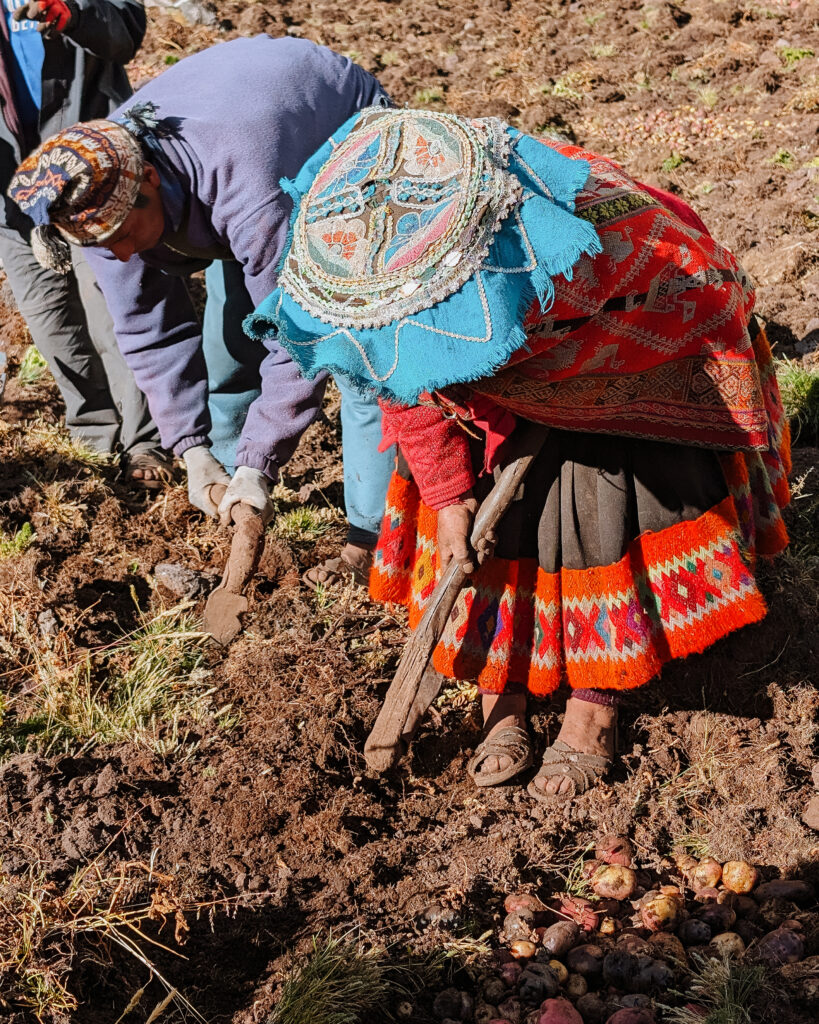
Dinner and Sleep Along a River
After walking through this agricultural area of the Lares Valley, we reached our second campsite, along the beautiful river that flows through the valley. It was time to eat another delicious dinner and get ready for another night camping. Once again, the temperature in the evening dropped below freezing and we were grateful for the hot water bottle in the sleeping bag and warm clothing for a comfortable night of sleep.
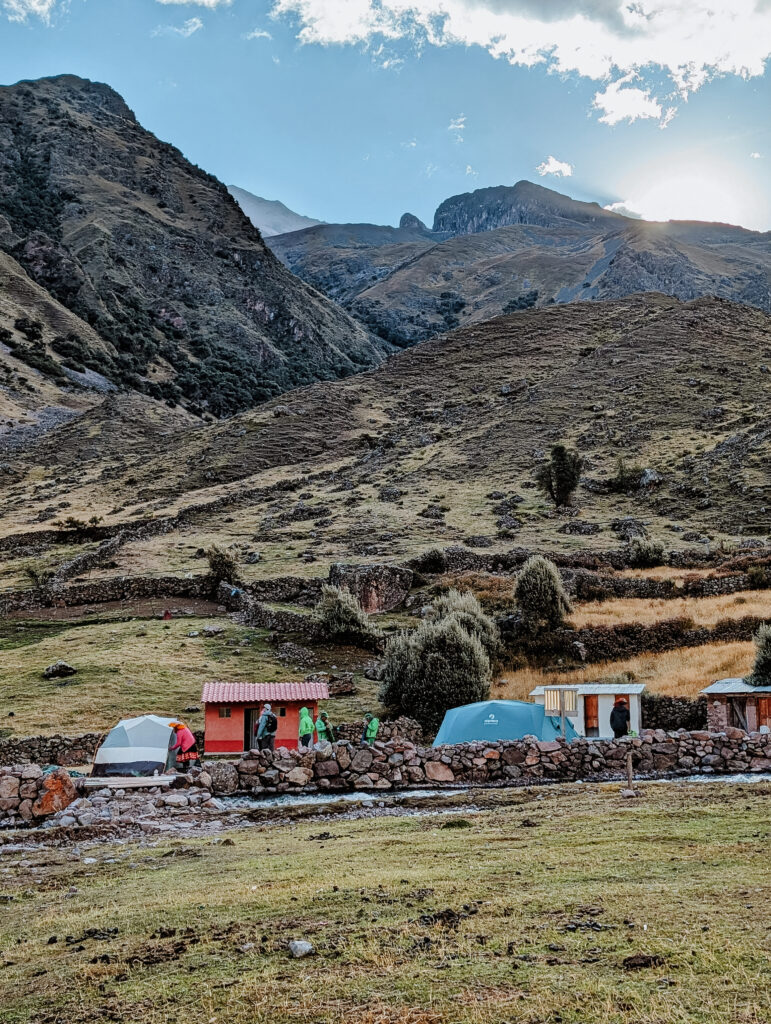
Day 3: End of the Lares Trek Trail
Wake Up Call and Breakfast
For our third day in a row, we were woken up at 5 AM, once again with a warm tea of coca leaves and some warm water with a towel to take a bird bath before getting dressed for the day. We packed up all our things into our duffel bags and emptied our tents.
Once again, we stuffed ourselves for our final breakfast on this hike and got ourselves ready for the last few hours of hiking. This hiking day would be our easiest one of the trek and would have completely different landscapes than walking through the mountains of the previous two days.
Our Morning of Hiking
This whole hiking day was downhill throughout, and as we moved down the mountain and valley, the plants changed to a more tropical environment. The plants got bigger and greener and we got to see ferns, wild pineapple plants, and large trees full of moss. It was refreshing to change from an open and barren landscape to a lush forest that provided us with shade. We even walked through a pack of alpacas idyllically grazing along a river within this forest.
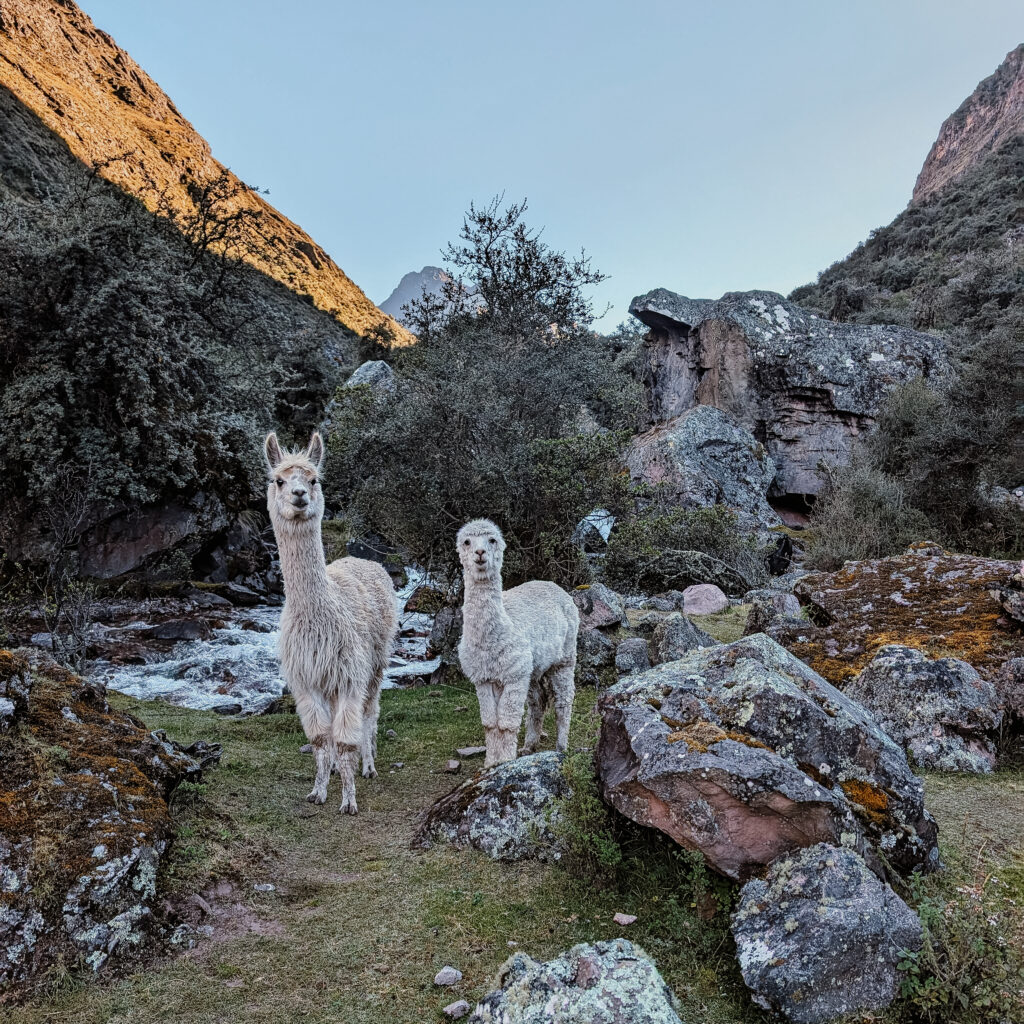
Ultimately, we arrived at a road (the first one we had seen in the last two days) and to our final destination on this hike, a small house in this village. Here we had a chance to put our things down and refresh ourselves before our final lunch. We were, once again, spoiled and stuffed to the brim with delicious Peruvian staples, including lomo saltado (stir-fried beef), mango ceviche, and more.
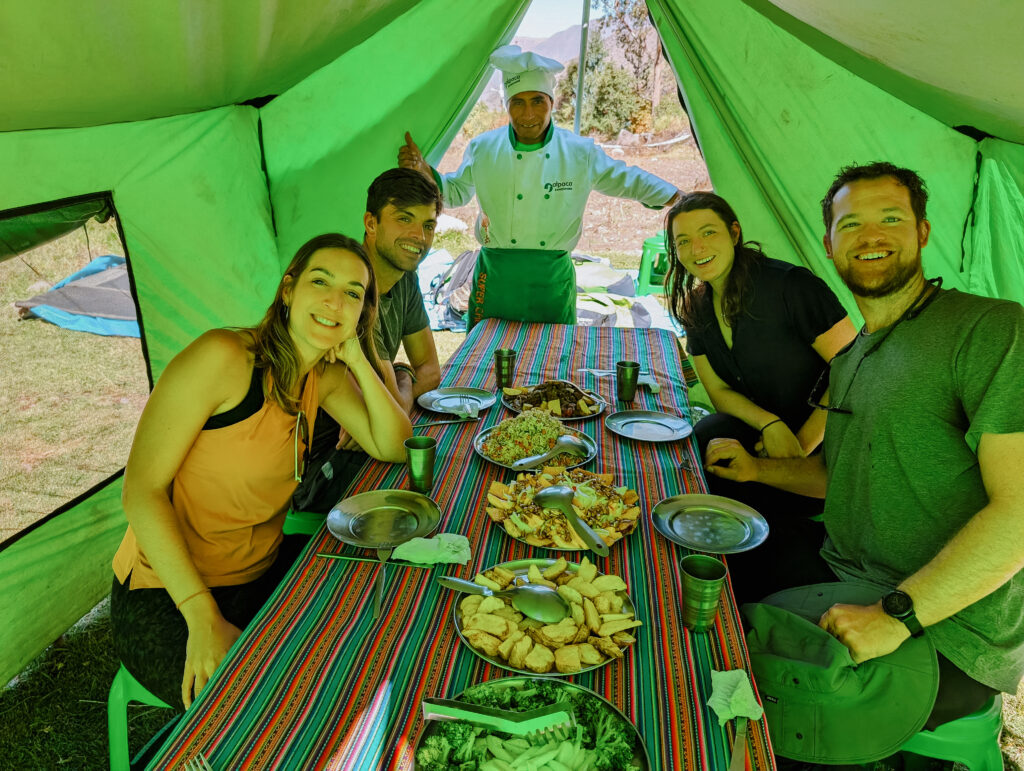
This would be our final meal with these chefs and porters and we ended our time here by thanking the team with kind words and a tip to show our appreciation for how amazing this team truly was. It was rewarding to be able to give support directly to the team that truly got us through this amazing hike.
Salineras de Maras and Then...
Despite this goodbye, it was not our final stop on this tour and we continued on with our guide, Max. We transferred ourselves and our duffel bags to a van that would take us to the famous salt mines, Salinas Maras. This destination is a beautiful artisanal salt mine, built into a mountain. The different salt containers are each owned by different families and have been around since pre-Incan times. They have designed a system that allows the salt water that comes from the mountain to flow around all of the salt containers to fill each of them with salt water. The owners of each container then mine the salt, package it, and sell it in a variety of forms. We purchased some bars of salt dark chocolate to enjoy as a reward for completing the trek.
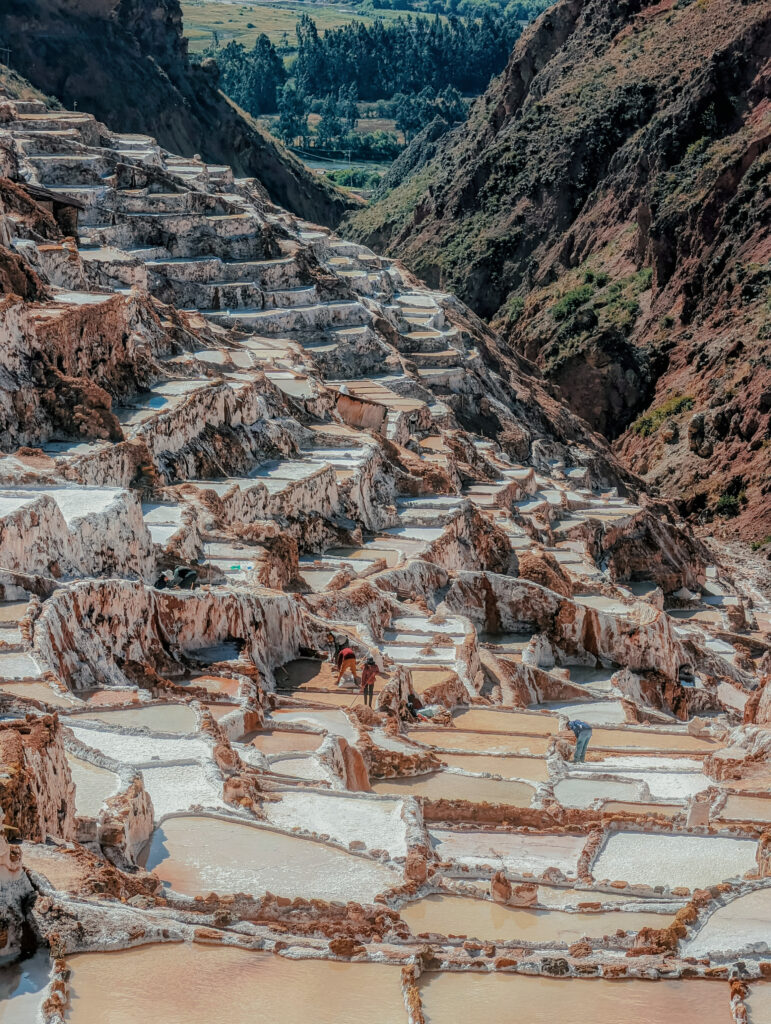
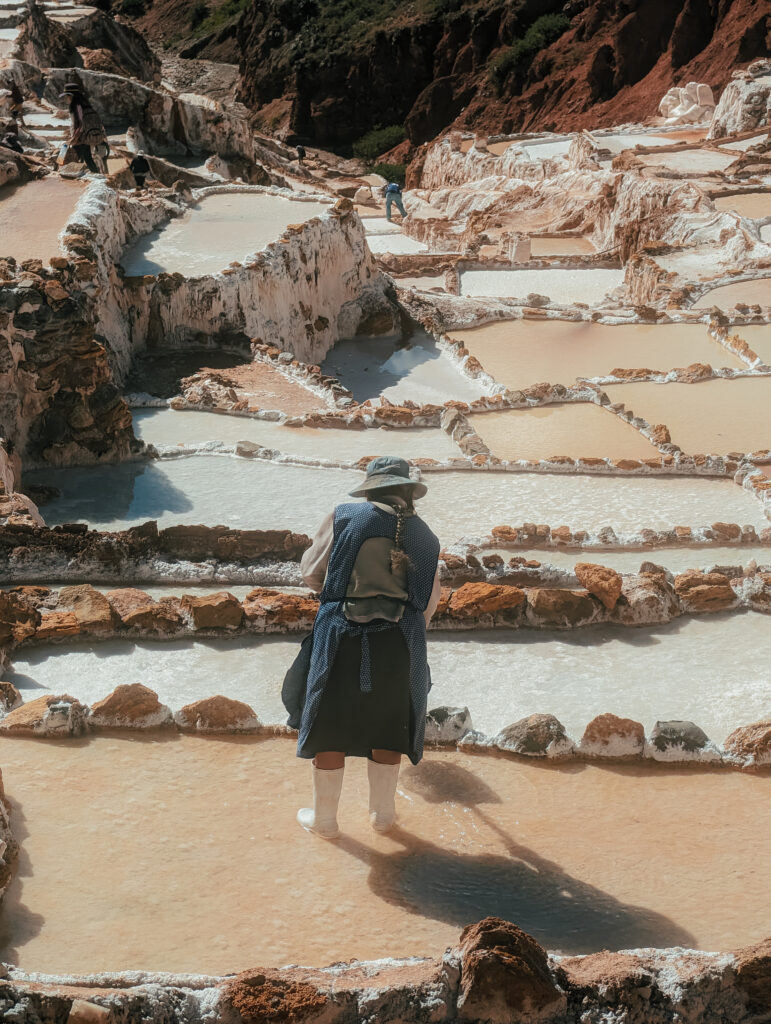
The next part of the Lares Trek adventure is going to Machu Picchu. There are two ways to go to Machu Picchu with this trek, a one-day visit or a two-day trek. (We talk about these two options below.) Because we opted for the two-day trek, it was our time to part with our fellow hikers and our incredible guide who were doing the 1-day visit to Machu Picchu the next day. We were dropped off at a hotel in the town of Ollaytaytombo where we said goodbye, thanked, and tipped Max for supporting us through the hike.
We had the evening in Ollaytaytombo to ourselves and it was very refreshing to get the chance to take a proper shower and sleep in an actual bed for the evening (especially since the next portion of our trek included camping again). We also got a dinner, organized by Alpaca Expeditions, at a local restaurant, and while the food here was delicious, we truly missed the delicious cooking of the chefs on our hike.
Those who continued the one-day visit to Machu Picchu took the afternoon train from Ollantaytambo to Aguas Caliente, the town at the base of Machu Picchu. This allows them to be on one of the first buses up the mountain to visit this incredible site the next day.
Two Machu Picchu Visit Options
There are a variety of options available when visiting Machu Picchu. With this particular hike and other “alternative hikes”, there are truly two options to see this World Wonder. The choice may depend on the amount of time you have to dedicate to visiting Machu Picchu, but if you can, we would highly recommend extending your trip to include the two-day trek and visit to the site.
1-Day Visit to Machu Picchu
If you are doing the 1-day visit to Machu Picchu from this trek or another “alternative hike”, you will spend the night before your Machu Picchu visit in Aguas Caliente. The day prior, you will have taken a train from Ollantaytambo to Aguas Calientes, the town at the base of Machu Picchu, and from which you will take the buses up to the site.
You will wake up early in the morning, eat breakfast at your hotel, and get onto one of the first buses to reach Machu Picchu. Here you start your tour by first visiting the overview platform, from which you see the iconic view down over Machu Picchu. Then, you follow a circuit to visit a variety of areas within the site and learn about the Incan population that lived and visited this magical place.
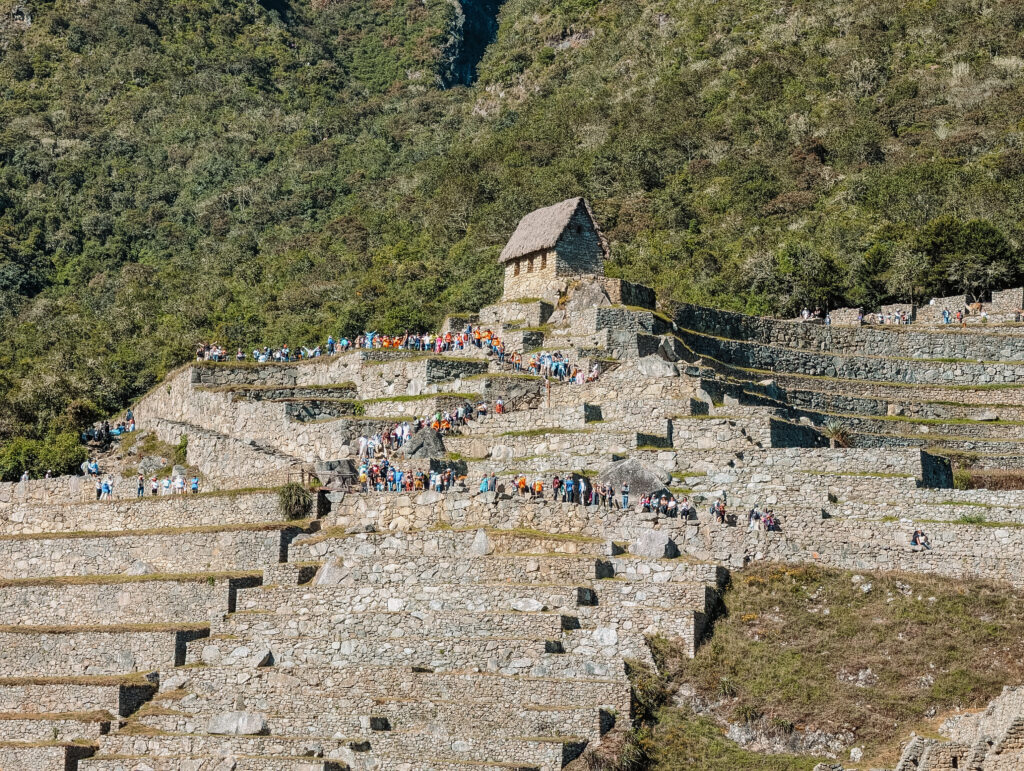
If you reserve a hike to Huana Picchu or Machu Picchu mountain, this is the time that you do that hike. These are not required hikes and are quite challenging due to the steepness of the mountains and the number of stairs that you will climb, but they have great views of this World Wonder and the surrounding mountains. These hikes need to be reserved far in advance, especially when traveling during the peak season.
Finally, you end your day with lunch in Aguas Calientes before taking the train to Ollantaytambo and finally a bus back to Cusco.
By doing this early morning visit to Machu Picchu, you avoid many of the day visitors who come to the site directly from Cusco. These people will not arrive and flood Machu Picchu until later in the morning, but they will be walking the same circuit as you to visit the site.
2-Day Trek to Machu Picchu
We opted for the two-day trek to Machu Picchu because we wanted to visit the Sun Gate and hike part of the Inca Trail (which can only be seen on the Classic 4-Day or Short 2-Day treks). This short two-day Inca Trail hike can be done in conjunction with an “alternative hike”, such as the Lares Trek or the Salkantay Trek, or can be done as an experience independent of a larger hike. When visiting Machu Picchu, we suggest doing at least the short two-day Inca Trail because the experience makes Machu Picchu feel even more magical and gives you a richer cultural experience.
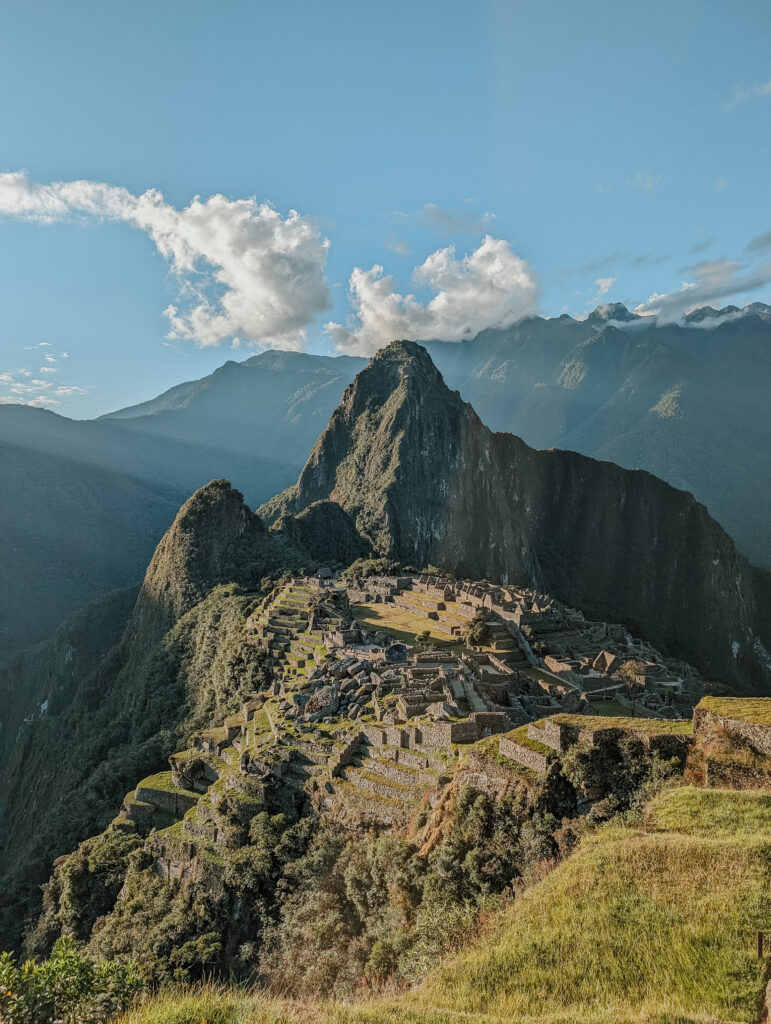
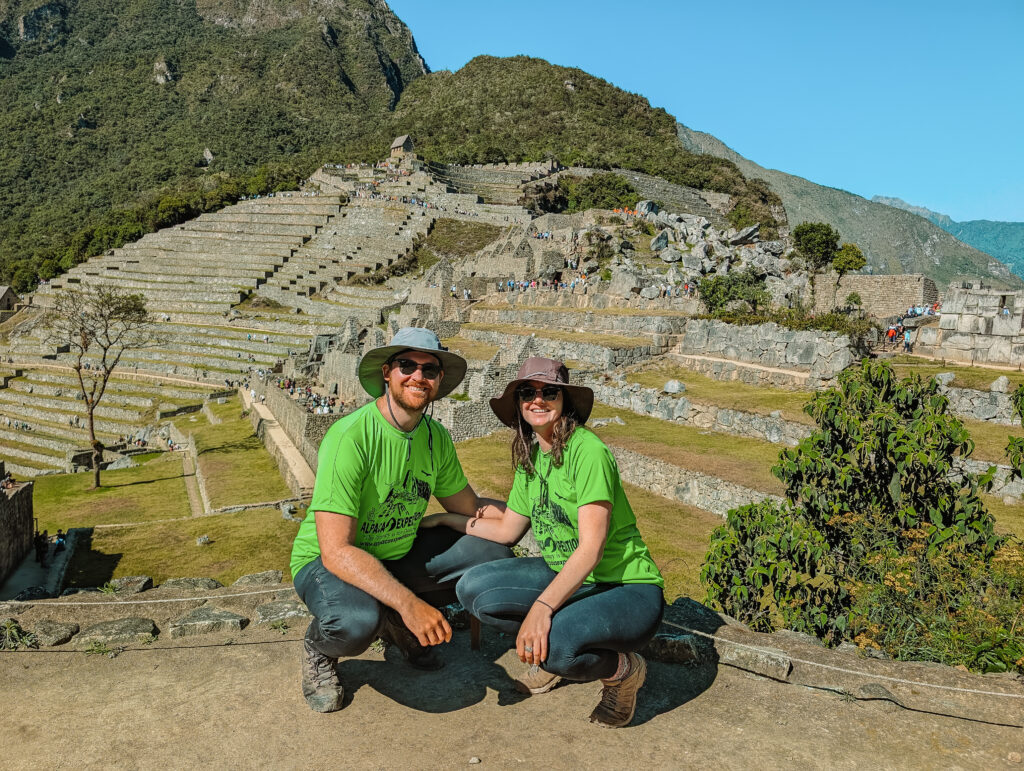
The reason we chose this option (and why we would always recommend the Short Inca Trail to anyone not doing the Classic Inca Trail is because (1) you get to visit other valuable and beautiful archaeological sites along the way that the Incan people would have also visited on their way to Machu Picchu, giving even greater context to the destination. (2) you arrive at Machu Picchu on the first day at sunset and get to experience the place with very few other visitors. (3) When you tour the Machu Picchu site on the following day, you will be on a circuit with other hikers so the tour itself will not feel overwhelmingly crowded. (4) To take it all in, you truly need two days to absorb the monumental beauty around this World Wonder.

